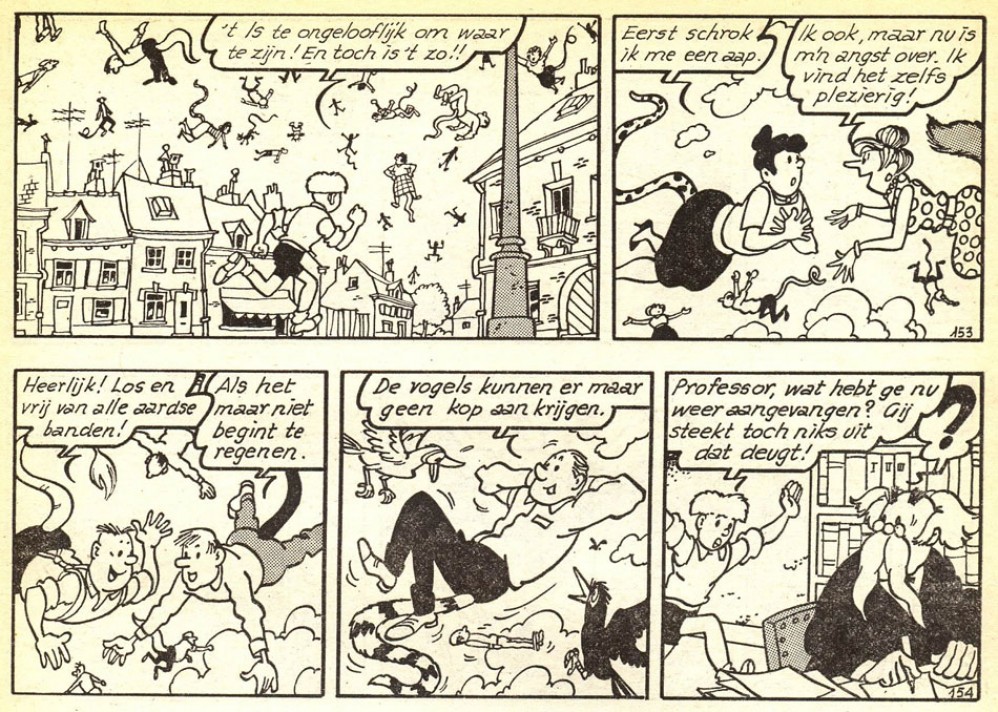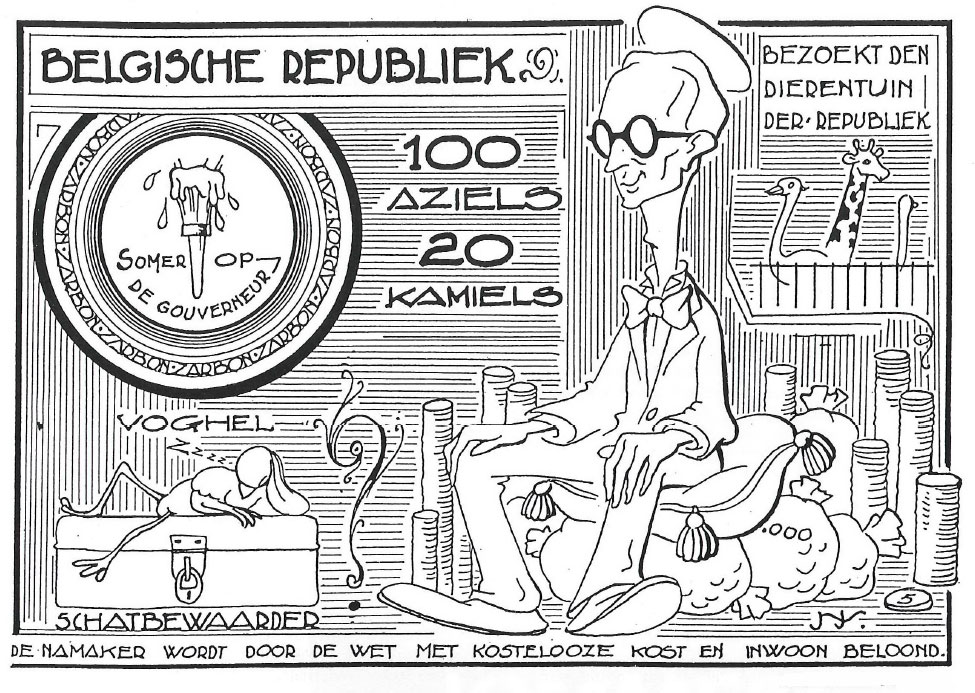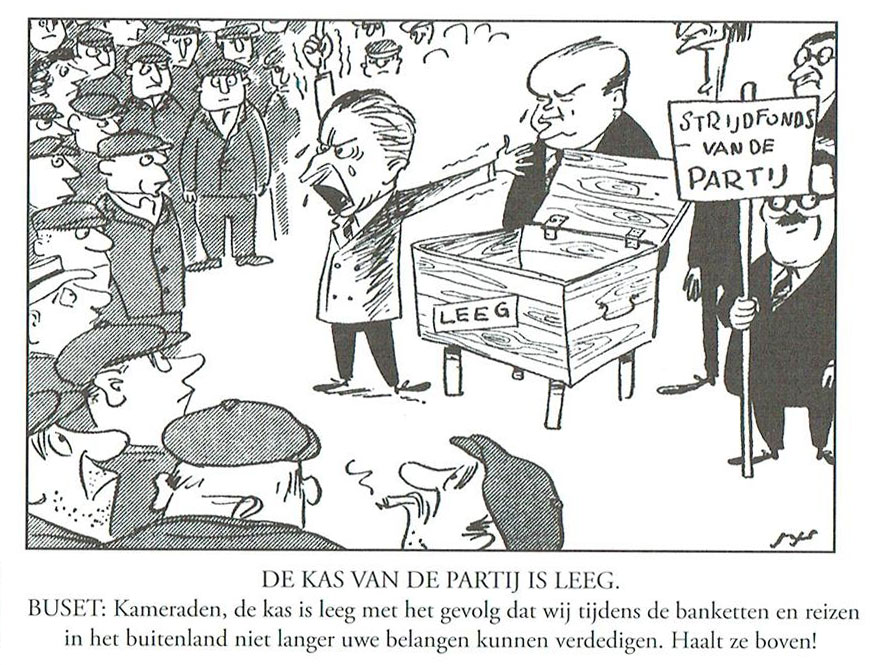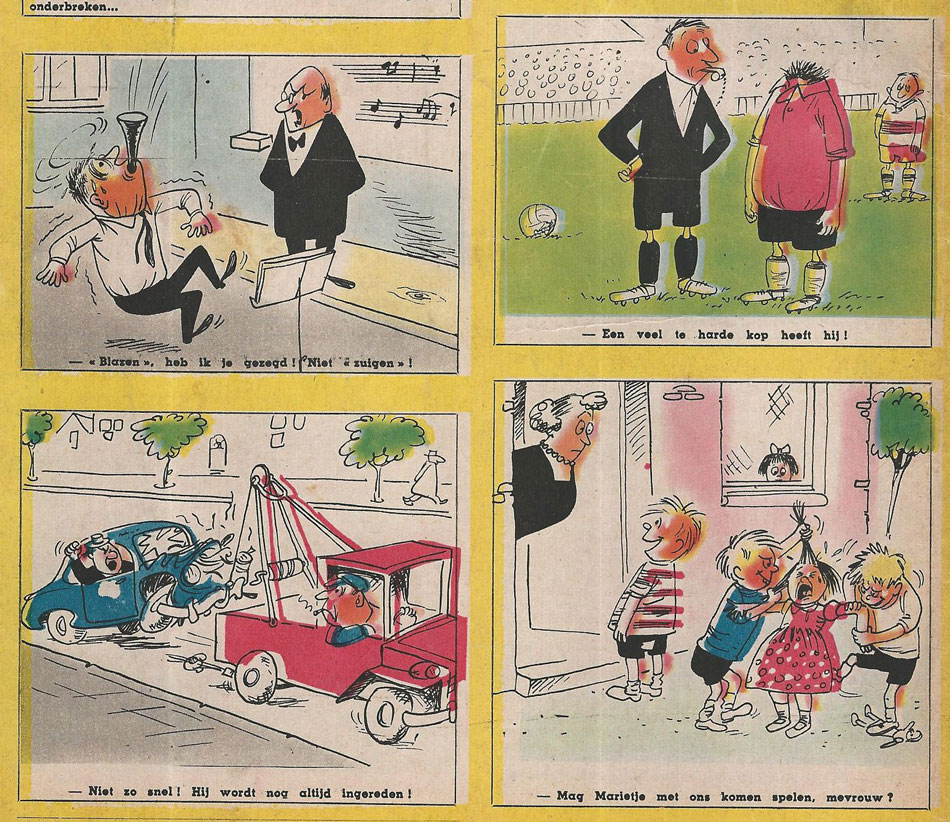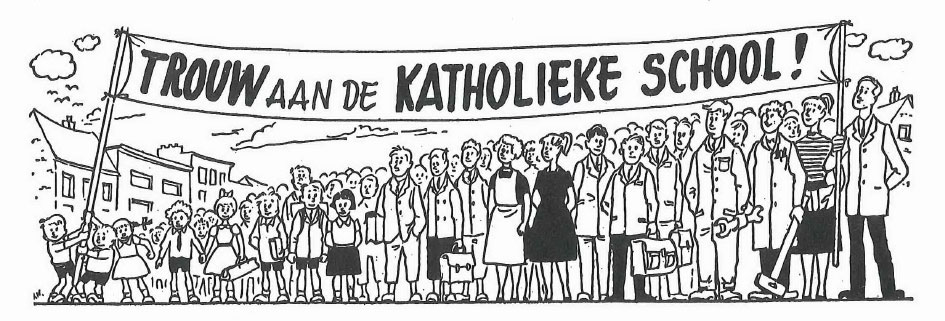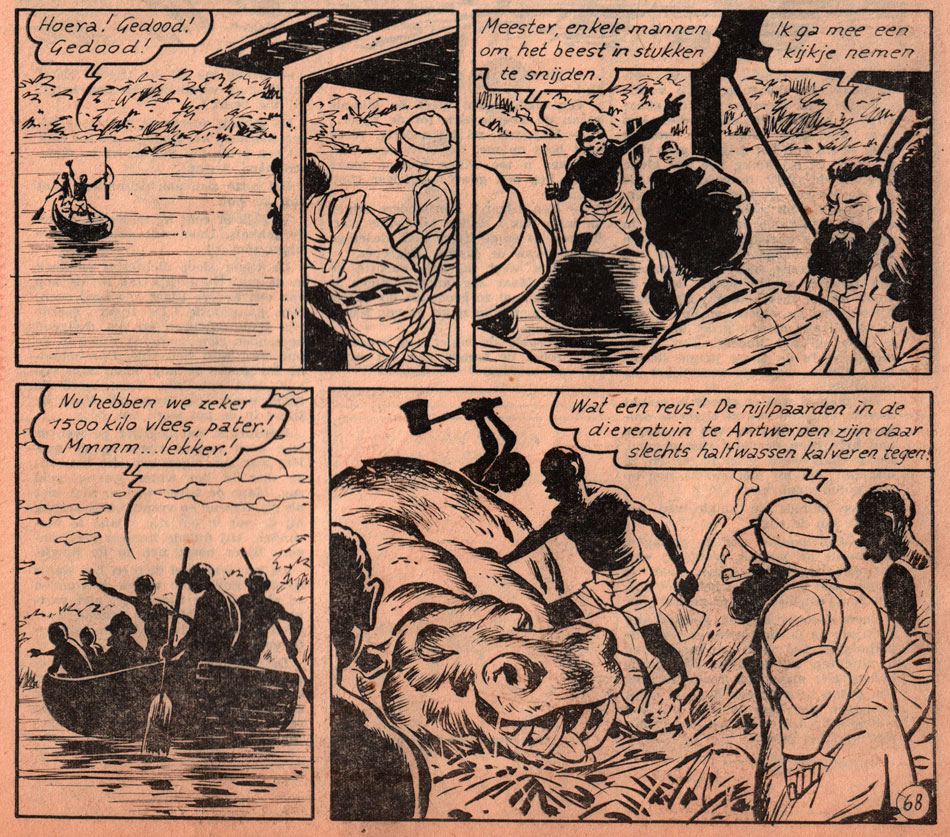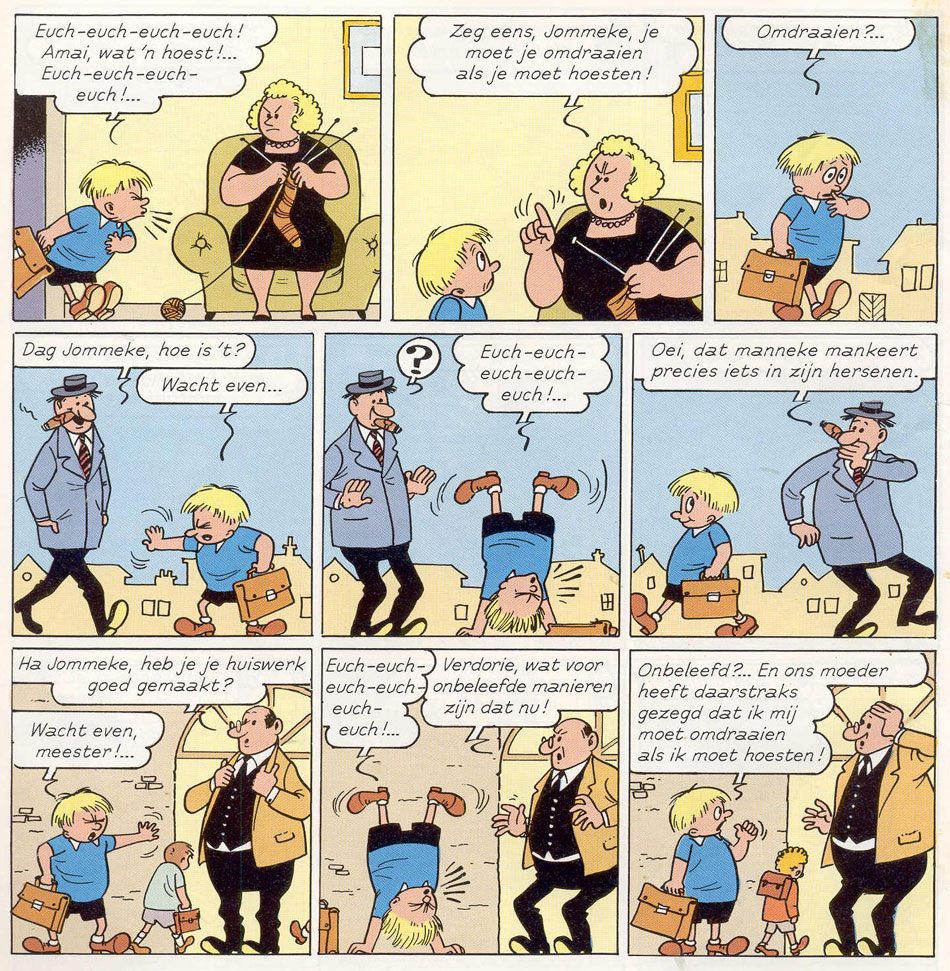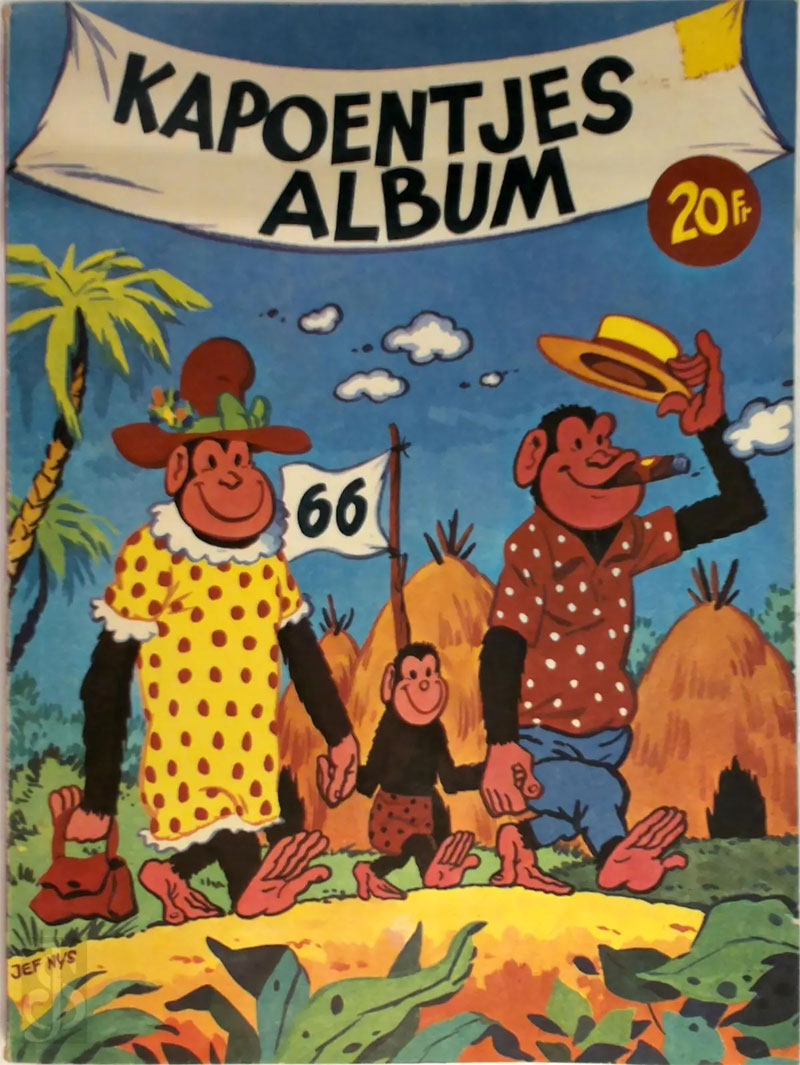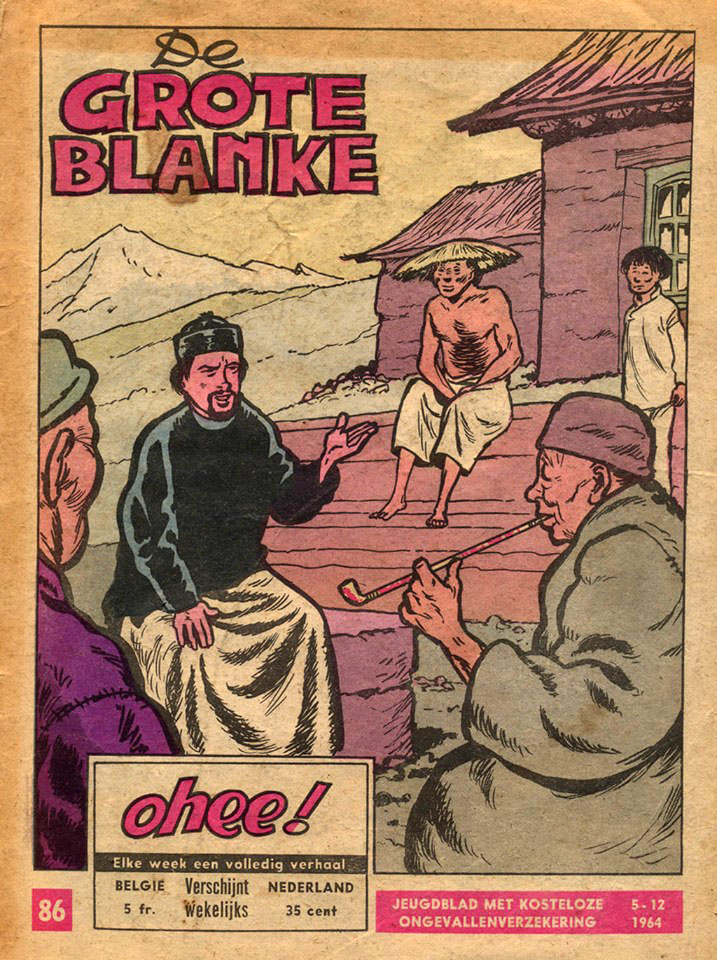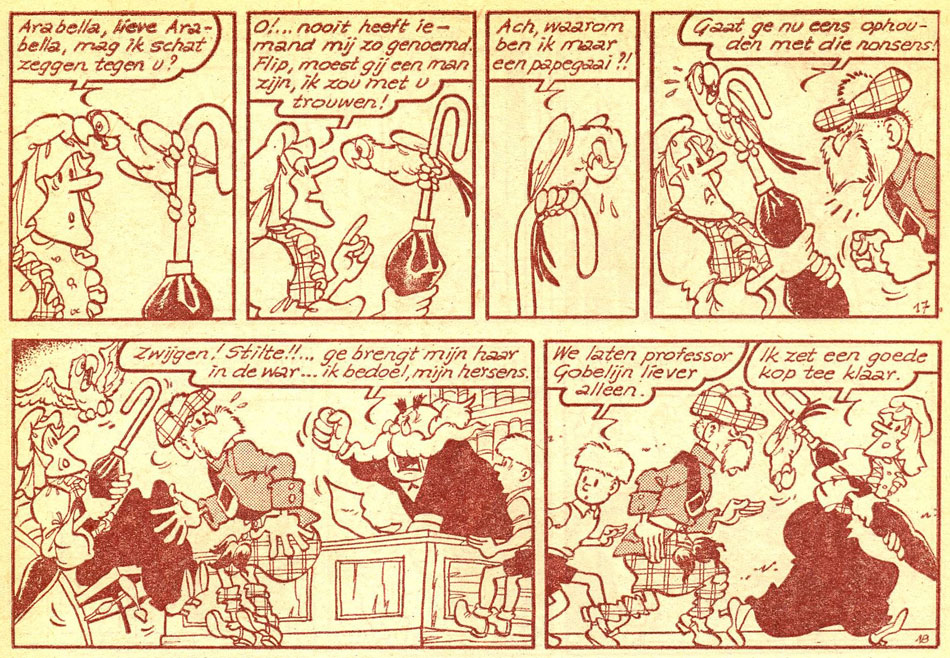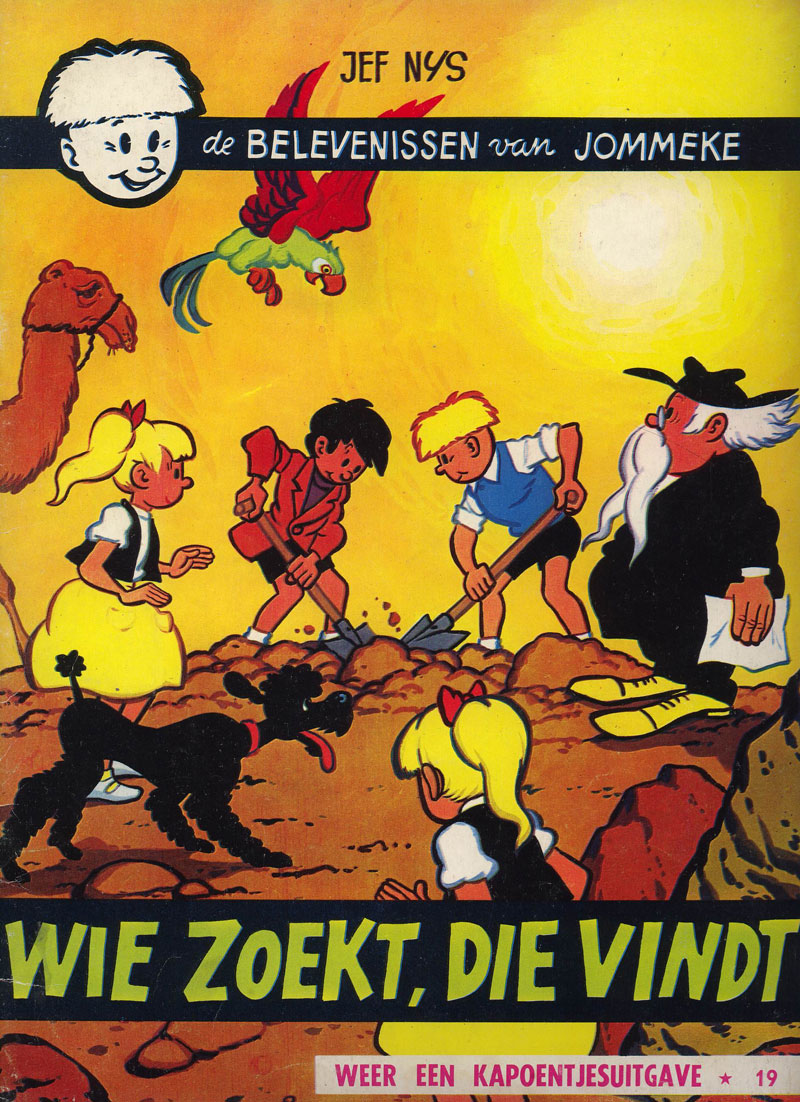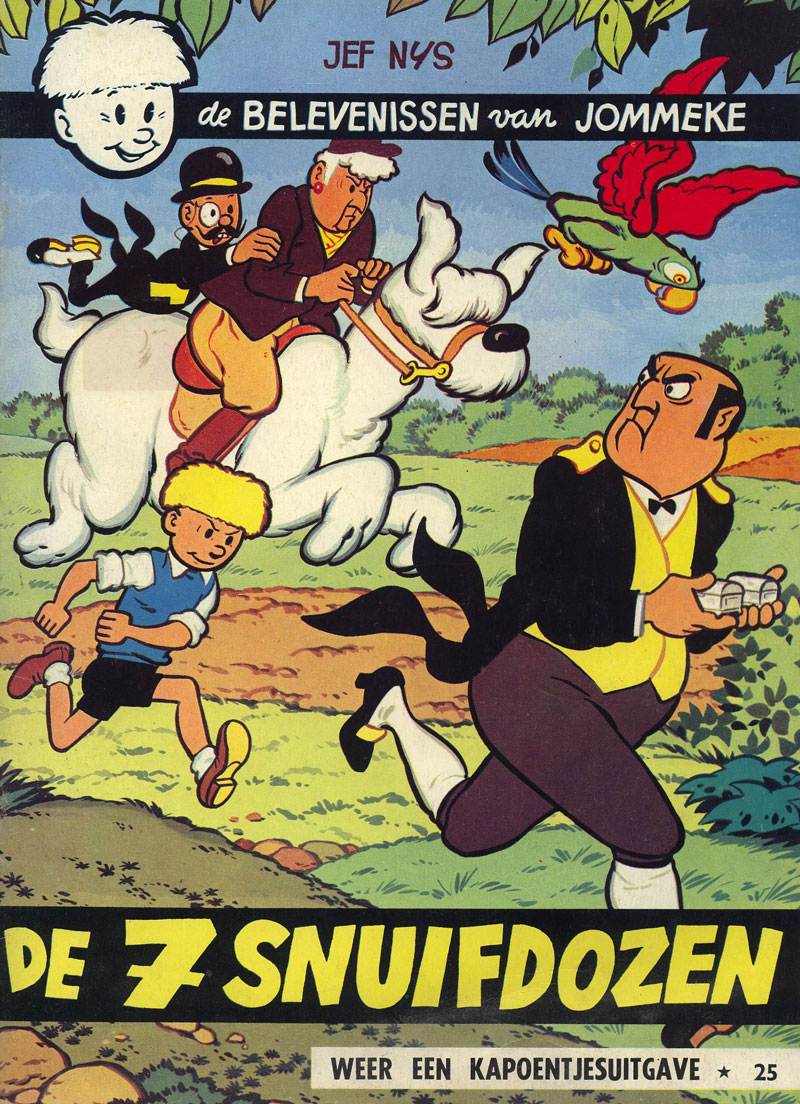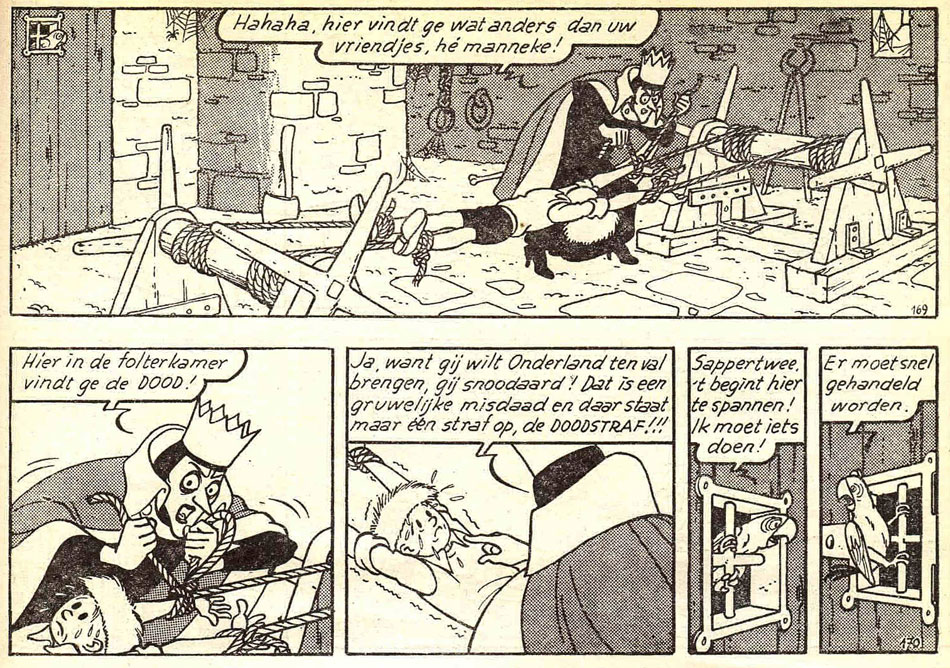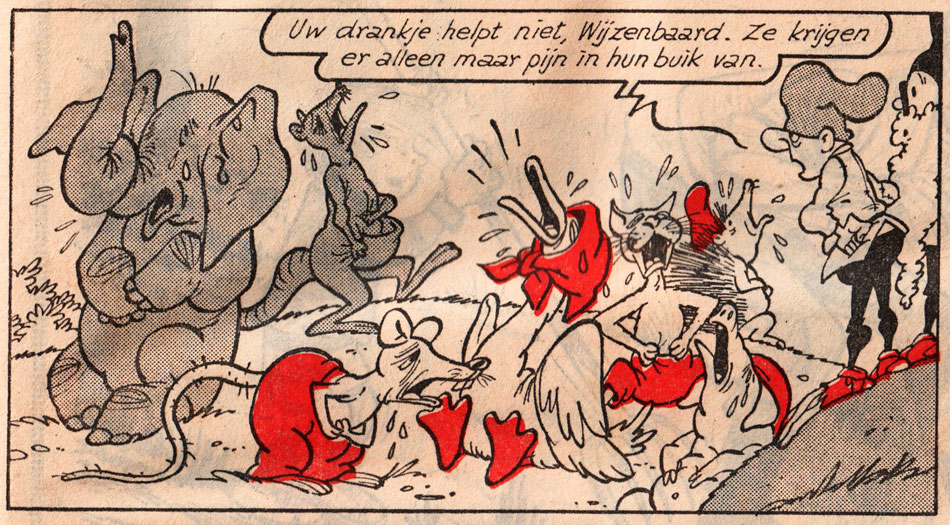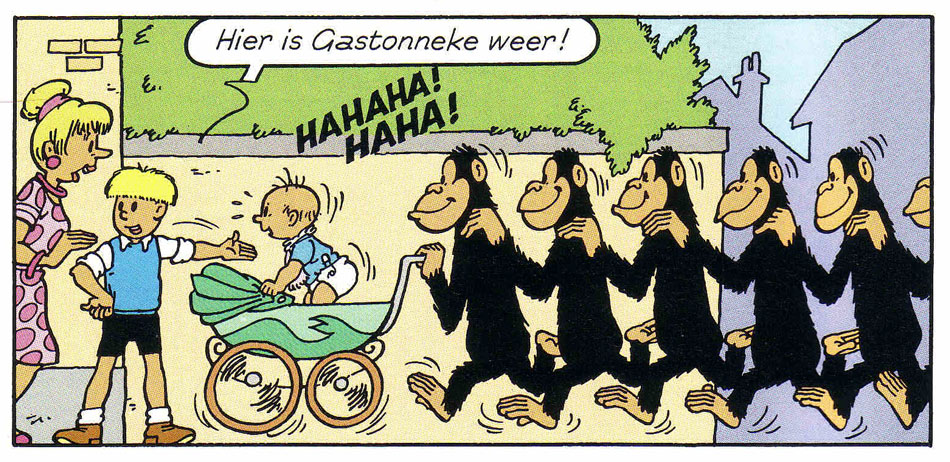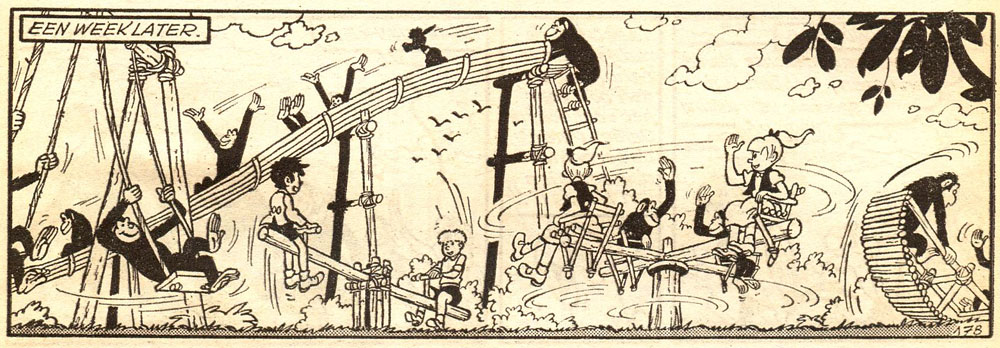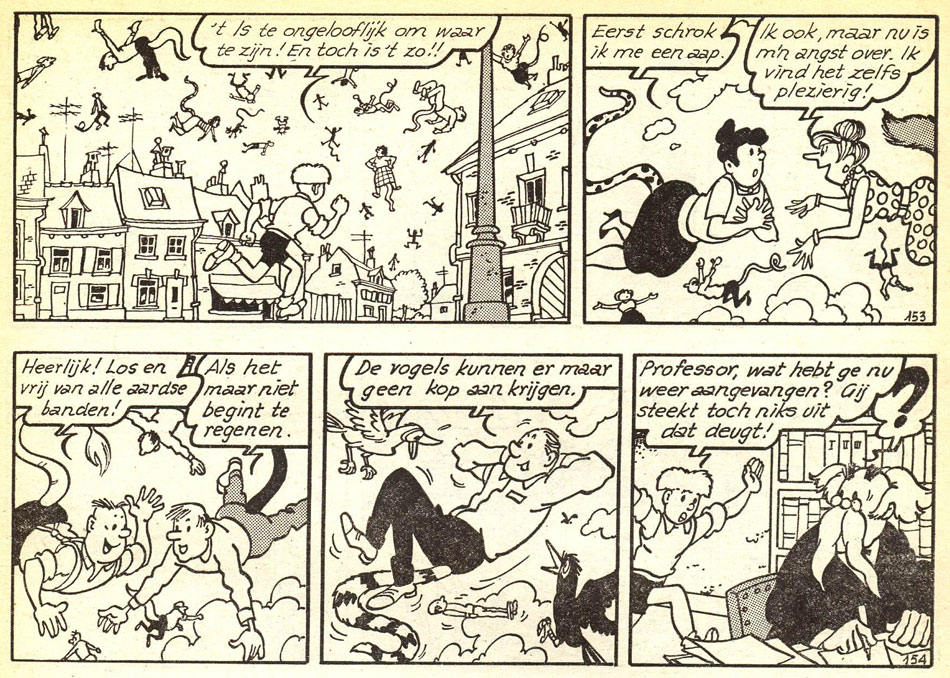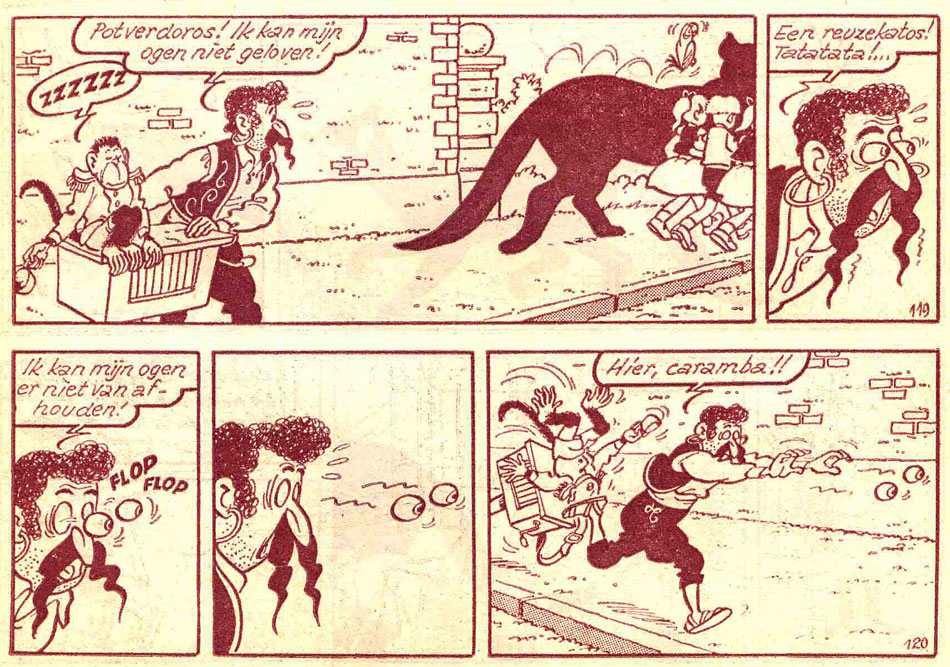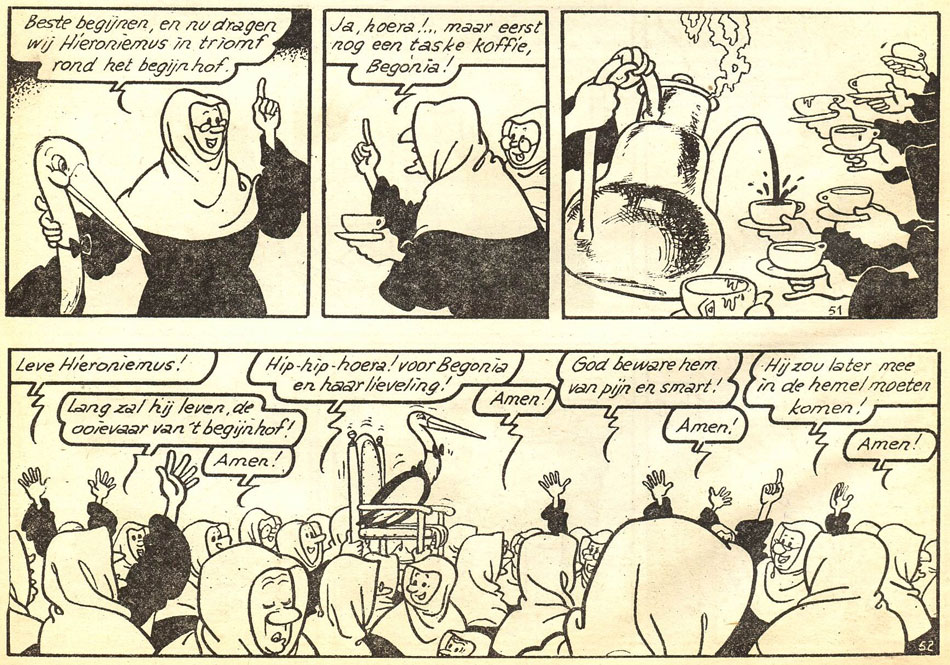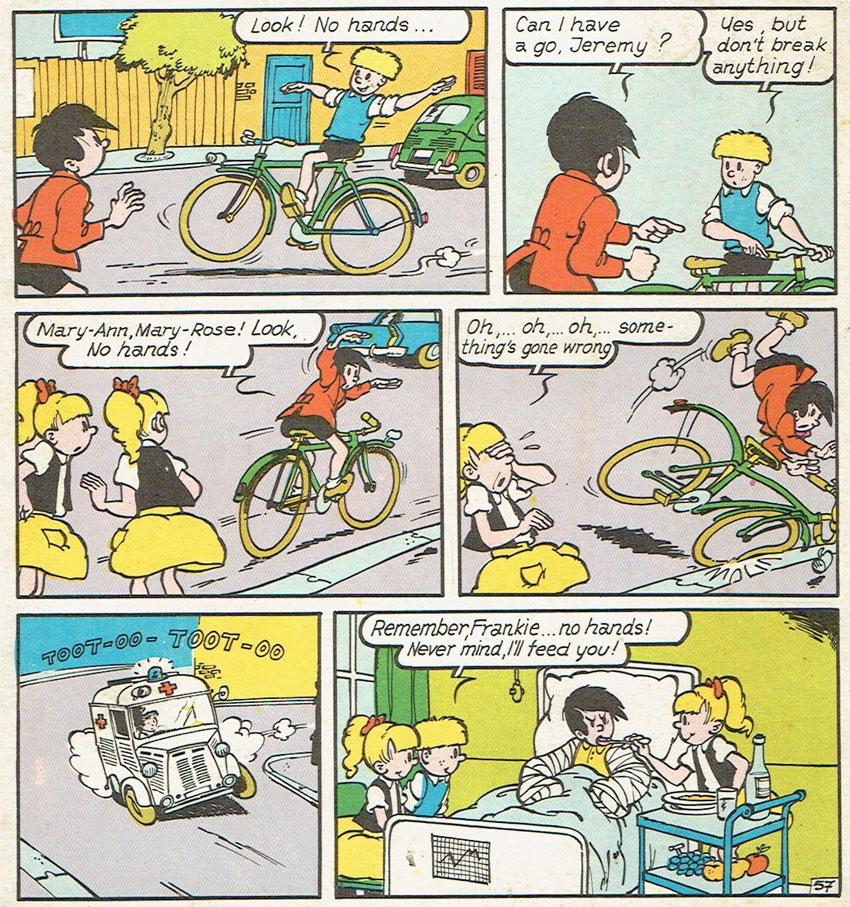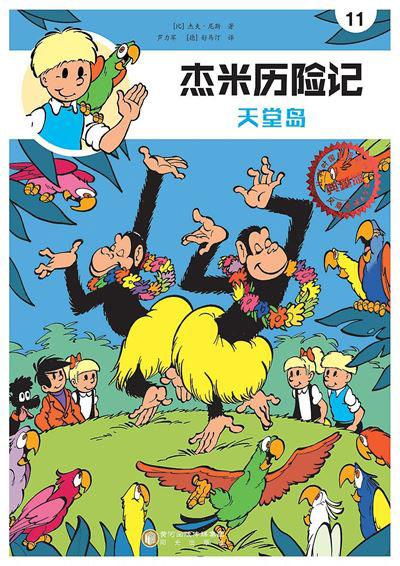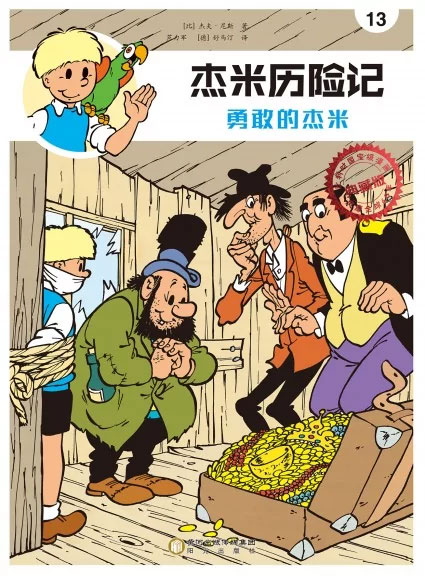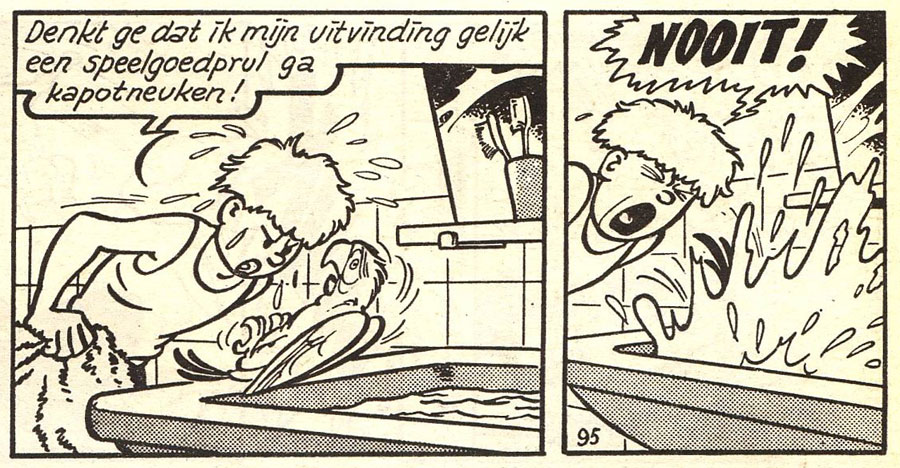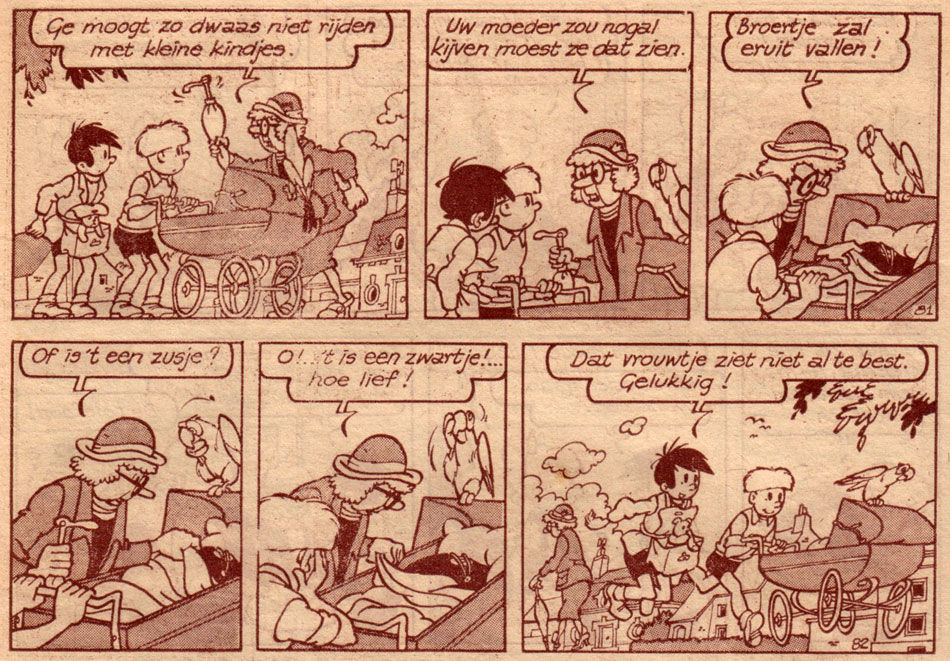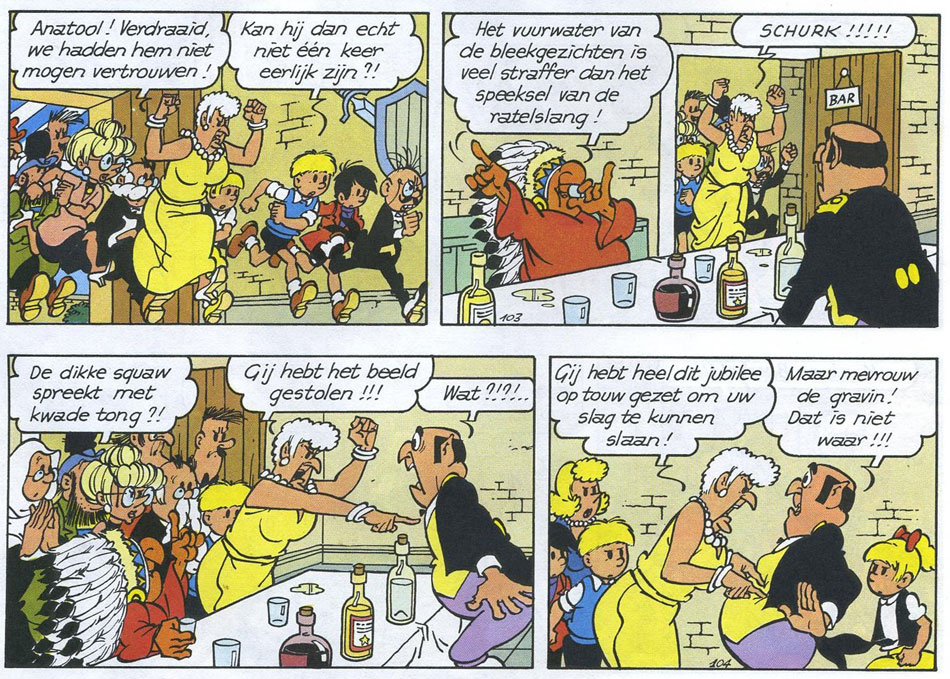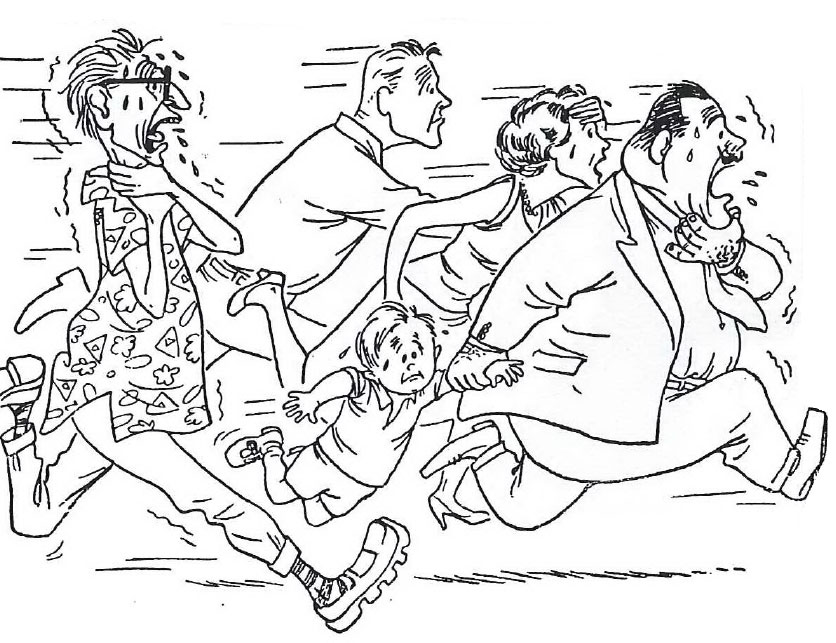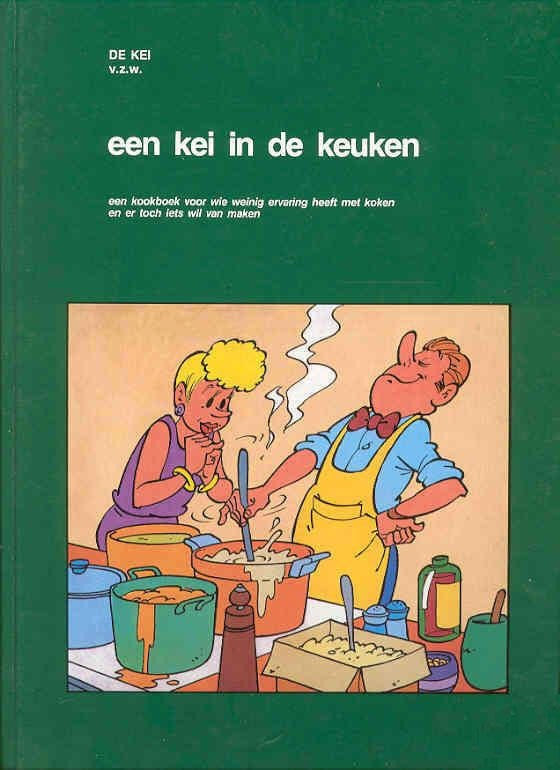Jommeke - 'Kinderen Baas' (1966).
Jef Nys was a Belgian children's comic artist, best-known for his iconic series 'Jommeke' (1955- ). Generations of Flemish boys and girls have grown up with the adventures of the bowlcut-haired boy, his friends, their pets and absent-minded professor Gobelijn. The comic remains a best-seller in Flanders today, spawning various merchandising items and its own newspaper supplement, de Jommekeskrant (1989-2006, 2008-2022). After Nys' death, 'Jommeke' also started crossing borders, finding remarkable success in Germany, Indonesia and even China. Nys additionally created the fairy tale comic 'Met Langteen en Schommelbuik Voorwaarts' (1963-1967) and, in a more realistic style, biographical comics about historical Roman Catholic figures. Still, throughout his career, Nys has always been more popular with general audiences than with critics, who deemed his plots naïve, formulaic and square. His reputation only improved later in life, when he was credited as a fine children's story teller and undisputable graphic talent.
Early life and career
Jef Nys was born in 1927 in Berchem, as the son of a lock keeper. Nys' grandfather was an amateur landscape painter, from whom the boy inherited his gift for drawing. In three years time, the child had to cope with three deaths in the family. His younger brother died at age 2 from convulsions and his younger sister at age 8 from a brain tumor. When Nys' father went to visit his daughter's grave, he was hit by a streetcar and died from his wounds. Nys went to the local art academy of Berchem and later the Vak- en Nijverheidsschool (Vocational and Industrial School) in Borgerhout to become a technical engineer. He earned extra income by selling caricatures of his teachers to fellow students. Eventually Nys dropped out of school and, at his teachers' advice, went to the Royal Academy of Fine Arts in Antwerp, where one of his classmates was Bob De Moor. De Moor asked Nys to join in at the Antwerp animation studio AFIM, where a team led by Ray Goossens was working on an animated short called 'Smidje Smee'. However, his principal at the Academy felt animation was "beneath him" and forced Nys to make a choice. As a result, Nys left AFIM after only four days. On 13 October of that same year, the Academy had to close down anyway, after a V1 bomb exploded in its garden. Nys never completed his academic studies, nor ever worked in animation again, much to his eternal regret. Instead, Nys got a job as technical assistant of architect Maurits De Vocht. Throughout his career, Nys continued to use his talent for making technical drawings, both in his cartoons and his comics.
Early in his career, Jef Nys enjoyed making technical cartoons for 't Pallieterke.
Unlike most other post-World War II Belgian comic artists, Nys rarely read comics. During his youth, he was far more impressed with traditional painters like Pieter Bruegel the Elder and editorial cartoonists like Saul Steinberg and Eugène Winters, as well as the children's illustrators Joz De Swerts and Jan Waterschoot. Later in life, Nys also expressed admiration for political cartoonist Marec. He was influenced by Hergé, André Franquin, but above all by the animated films of Walt Disney. Particularly 'Snow White and the Seven Dwarfs' (1937) and 'Bambi' (1942) made a lasting impression, with several fairy tale characters and anthropomorphic animals in Nys' later comics having an undeniable Disney-esque design, like the Queen of Onderland and Haakneus the witch. In 1947, Nys wrote an application letter to the Walt Disney Company, who expressed admiration for his skills, but had no job for him.
Cartoon depicting socialist politician Camille Huysmans in the style of a money bill, the winning entry in a contest by 't Pallieterke that earned Jef Nys a spot in its pages from 1945 on. While the cartoon expresses the fear that Huysmans' election as Prime Minister would turn Belgium into a republic, no such thing ever happened in real life.
't Pallieterke (1945-1956)
In 1945, Nys participated in a readers' contest, organized by the newly-founded satirical weekly 't Pallieterke. Contestants had to design a fake banknote in which the socialist politician Kamiel Huysmans (1871-1968) was featured as the first president of the Belgian Republic. Out of 142 submissions, Nys and fellow artist Willy Mertens were declared the winners and instantly became house cartoonists for the publication. Ideologically, 't Pallieterke was Flemish-nationalist and right-wing conservative and so Nys' political cartoons and caricatures expressed the same opinions. However, he also livened up their sports and film column with caricatures, while also drawing more straightforward, apolitical cartoons, for instance about sports. A popular series by Nys were the literal visualizations of well-known proverbs, sayings and expressions.
The first comics by Jef Nys appeared in 't Pallieterke, signed with the anglicized pseudonym "Jef Nice". His earliest effort, 'Adam Leeft Nog' (1948), was a humorous comic set in Africa, more specifically Egypt, but Nys was dissatisfied with the plot and abandoned it halfway through. He felt more at ease with 'De Familie Knol' (1948), a feature about a dysfunctional family. Father Knol is a nitwit, his wife a domineering bully, and their children Nol, Nelleke and Knolleke brats. The most interesting side character is the family's pet parrot, who gives sarcastic commentary and can be regarded as an embryonal version of the Bacchus character in 'Amadeus en Seppeke' and Flip in 'Jommeke'.
During this same period, Nys' former AFIM colleague Ray Goossens made a children's comic titled 'Snops en de Bende' (1946-1951), which featured two boys and a talkative parrot, not unlike Nys' later characters Jommeke, Filiberke and Flip. It is unknown whether Nys was aware of this comic strip. In 2024, both 'Adam Leeft Nog' and 'De Familie Knol' were released as one comic book by 't Vlaams Stripcentrum as part of their Fenix Collection. Many sources have incorrectly claimed that Nys was also the creator of the gag comic 'Kadodderke', although this anonymous artist has a different graphic style and signed with the picture of a sail boat.
Political cartoon for 't Pallieterke, depicting head of the Belgian socialist party Max Buset next to an empty party fund. The corpulent man in black is Paul-Henri Spaak, the tall one Camille Huysmans and the one holding a sign Achille Van Acker. Translation: "Comrades, the fund is empty, meaning that during banquets and travels abroad we'll no longer be able to defend your interests. Present them!"
In 1955, 't Pallieterke's founder Bruno De Winter passed away. The new editors radicalized the magazine's politics, pushing it further to the far-right, much to Nys' dislike. In November 1956, he left the publication. All of Nys' cartoons and comics in the magazine have been compiled by Thomas Verachert in 'Jef Nys: De Beginjaren Als Cartoonist' (Polemos, 2015).
Early cartoons by Jef Nys, published in Humo magazine of 4 July 1954.
Cartoons in other publications
Throughout the second half of the 1940s and the early 1950s, Nys also made freelance illustrations and cartoons for Gazet van Antwerpen (for instance about the 1946 elections), De Autotoerist and the party magazine of the Christian-democratic party CVP. A prominent topic in Nys's political work for CVP was the Belgian "royal question", a political crisis about whether the Belgian King Leopold III could return to the country and resume his role as monarch, despite his questionable actions during the Nazi occupation in World War II. Another subject tackled by Nys was the Belgian School War, revolving around the extent of religious influence in public education.
"Loyal to the Catholic school!"
De Gazet van Antwerpen ('De Lotgevallen van Jef Neus')
As a freelance artist for the Antwerp newspaper Gazet van Antwerpen, Nys created the four-panel gag comic 'De Lotgevallen van Jef Neus' (1952), signed with the pseudonym "Seppe". Jef Neus is a big-nosed, mustached man who usually smokes pipe. In the first gag, he is brought to the newspaper's editorial office by a stork, despite already being an adult. He then introduces himself to the readers. This was the only time dialogue was used, as all of the other 'Jef Neus' gags are presented in pantomime. Only signs on walls or posters occasionally featured text.
'De Lotgevallen van Jef Neus' (1952).
Het Handelsblad ('Amadeus en Seppeke')
Between 1954 and October 1955, Nys created his first completed adventure comic, 'De Lotgevallen van Amedeus en Seppeke', serialized in the newspaper Het Handelsblad. The title character, Amedeus, is basically Jef Neus from Nys' previous comic, only with a shorter nose and a different name. His pet parrot Bacchus was recycled from Nys' gag comic 'De Familie Knol'. Many characters in 'Amadeus en Seppeke' were prototypical versions of the main cast in Nys' later signature series 'Jommeke'. The tall mustached Amedeus is similar to Jommeke's father Theofiel, while the young blond boy Seppeke is basically Jommeke with a different haircut. In their first story, the duo meets an absent-minded professor, Mattias Corpusje, and an evil female castle owner, Zagoga Kwist. Corpusje looks very similar to the 'Jommeke' character Professor Gobelijn, while Zagoga is a prototype for the Queen of Onderland. The only character already completely fleshed out is the untrustworthy butler Anatool, whom Nys later reused in 'Jommeke', virtually unchanged.
A total of four 'Amedeus en Seppeke' stories were serialized in Het Handelsblad, several of which had plots that were recycled for 'Jommeke' stories. The episode 'Jacht Op Een Teddybeer' was later recycled as the 'Jommeke' episode 'Jacht Op Een Voetbal', only with a hidden testament hidden inside a football instead of a teddy bear. 'De Diamanten Mummie' was rehashed as 'De Zonnemummie', and 'De Zilveren Schildpad' was the blueprint for 'De Schildpaddenschat'. In the 1980s, the 'Amedeus en Seppeke' stories were collected in book format in the Magnum collection of publisher De Dageraad.
Promotional strip for Ons Parochieblad, starring an early version of Jommeke (27 November 1955). Jommeke brings in numerous subscribers and actually prays for them to read it carefully, "because our priest says that they can find something in it to take with them for the rest of their lives."
Ons Parochieblad
From 1949 on, Nys was also a regular illustrator for the Catholic publisher Halewijn, which distributed the parish magazines to Catholic churches. By 1955, his role became more prominent, and between 1955 and 1958, he was a staff artist for the publisher. During this period, Nys was the main illustrator in Ons Parochieblad, a weekly that was later retitled to Kerkelijk Leven (in 1959) and finally to Kerk & Leven (in 1967). In 1955, chief editor Frans Janssens asked him to liven up their children's section. Nys wrote short articles under the title 'Voor Kleine en Grote Kinderen' ("For Small and Big Children"). The gag cartoon series 'Beeldende Woorden' (later 'De Vlaamse Woordenschat') was a continuation of a similar feature in 't Pallieterke and visualized proverbs and words of expression literally. Nys also created puzzle pages, educational articles and the humorous column, 'Het Opstel van Flupke', pretending to be a young boy writing a school report, complete with intentional errors and naïve observations. Among Nys' serialized comics were biopics about inspirational Catholic historical figures, and his gag comic 'Jommeke'. While his work in Ons Parochieblad was very popular, Nys often had creative arguments with Janssens about the printing quality which, according to him, ruined his drawings and their readability. In November 1958, Nys left the magazine, although he did complete his final biopic, which was serialized in 1959.
Cover illustrations for 'Bernadette' (about Bernadette Soubirous) and 'Berten Rodenbach' (about Albrecht Rodenbach).
Biographical Catholic propaganda comics
Between January 1955 and March 1959, Nys created several biographical comics for Ons Parochieblad about inspirational Catholic or Flemish historical figures. The first serial, 'De Wonderbare Jeugd van Pieter Bruegel' (1955-1956), focused on the painter Pieter Bruegel the Elder. The 1957 serial 'Berten Rodenbach, de Wonderknape van Vlaanderen' was a biopic about 19th-century Flemish poet and activist Albrecht Rodenbach, most famous for his poem 'De Blauwvoet'. 'Pius X, Van Volksjongen tot Paus' (1958) was Nys' first comic about a foreign historical figure, namely pope Pius X. He followed it up with 'Bernadette' (1958), about the mystic nun Bernadette Soubirous, published in the text comic format, with captions beneath the images. His final biopic, 'St. Godelieve' (1959), adapted the life of the medieval female saint and martyr Godelieve of Gistel. All stories were also published in book format by Halewijn. Especially 'De Wonderbare Jeugd van Pieter Bruegel' (1957) was incredibly rare for over half a century. In 2019, it was rereleased, thanks to efforts by Ivan Adriaenssens. All of the profits went to charity.
'De Stoutmoedige Voortrekker' ('t Kapoentje, 20 February 1963).
Between 1958 and 1963, Nys continued his biographical comics in the children's weekly 't Kapoentje, the youth supplement of newspaper Het Volk, where they ran under the title 'Vlaamse Kapoentjes die Beroemde Mannen Werden'. They were also reprinted in Ohee, another juvenile publication of Het Volk. 'Uit het Leven van Paus Johannes de XXIIIste' (1958-1959) was unusual because it adapted the life of then-current pope John XXIII. 'De Grote Zwartrok' (1959-1960) chronicled Pieter De Smet, a Flemish priest famous for converting Native Americans. 'De Reus van Bengalen' (1960) was a similar travel story about missionary Constant Lievens and his voyages to India. The next year, Nys created 'De Grote Weldoener' (1961), about Petrus Joseph Triest, founder of the Sisters and Brothers of Charity. He followed it up with 'Het Avontuur van een Bakkersjongen' (1960-1961), which dealt with Edward Poppe, a Flemish priest known for helping the poor, and 'De Trek naar China' (1961-1962), about Theophiel Verbist, missionary in China. His final biographical story was 'De Stoutmoedige Voortrekker' (1962-1963), about Constant De Deken, missionary in China and Belgian Congo. All titles were published in book format by Het Volk.
'De Schone Avonturen van een Bakkersjongen', about 19th-century priest and humanitarian Edward Poppe.
As a devout Roman Catholic, Nys drew these biopics because he felt it was his moral obligation to educate the youth about these inspirational figures. He did all research completely on his own. In some cases, there were only a few photographs available to model his characters on and so Nys had to imagine how these historical figures might have looked from different profiles. It pleased him that he could put his academic skills into practice and show readers he was capable of more than just humorous children's comics or adult political cartoons. Only the first story, 'De Wonderbare Jeugd van Pieter Bruegel', was drawn in a more comedic style and had no basis in historical facts. It was merely a series of gags, depicting Bruegel as a kid whose urge to doodle everywhere and everyone brings him into trouble with adults. In the later biopics, Nys could never resist the urge to start off with similar gag-like, fictional anecdotes about the historical protagonist's supposed childhood, just to capture the attention of his young readers. Contrary to his Bruegel comic, these later biopics then evolved into more serious and well-researched historical drama once the protagonist reached adulthood. Still, many facts were romanticized, with strong focus on "miracles", "divine intervention" and "eternal bliss" after death. The pro-Catholic, pro-colonial and very moralistic tone make these comics mostly interesting as a curiosity in Nys' career. In later interviews, while being proud of the works themselves, he jokingly admitted being unsure whether these comics actually convinced anyone to become a humanitarian, or a priest. The albums were later reprinted by Spirit Temse.
Debut episode of 'Jommeke' (Ons Parochieblad, 30 October 1955).
Jommeke: gag comic years (1955-1958)
In the children's section of Ons Parochieblad, Nys also launched his most famous series, 'Jommeke', debuting on 30 October 1955. During its first four years, it was primarily a one-page gag comic. The name Jommeke was lifted from a barhopper Nys knew, whose nickname was a derivation of the name "Guillaume". Physically, the character was modelled after Nys himself as a young boy, down to his trademark blond bowl haircut. In the first episode, Jommeke is delivered to the paper's editorial office by a stork, despite being already five years old. He hints that he'll be a mischievous brat and smokes a pipe, scaring the editors, "because you don't look like an easy pussycat." Despite this promising introduction, Jommeke's behavior was quickly toned down. He became a decent child who means well, but whose naïvité often gets him into trouble he didn't quite foresaw. Originally, he was drawn as a chubby five-year-old, but received a redesign later on, to become a slender 10-year old boy. Jommeke's parents, Theofiel and Marie, were also introduced during this early incarnation. Among the early 'Jommeke' gags were reworkings from previous 'Familie Knol' gags, or direct promotions for Ons Parochieblad, Catholic schools or the Catholic missions.
The 'Jommeke' gags from Ons Parochieblad were collected in three volumes by publisher Halewijn, simply titled 'Album 1' (1957), 'Album 2' (1957) and 'Album 3' (1958). They were later reprinted (and colorized) as 'Dolle Fratsen' (1965), 'Gekke Grappen' (1968), and 'Guitenstreken' (1982). After joining the newspaper Het Volk and its children's magazine 't Kapoentje in 1958, Nys sometimes recycled old 'Jommeke' gags from Ons Parochieblad, but updated the artwork and added more of Jommeke's new side characters. These gags were later recollected in the books 'De Jommekesclub' (1970), 'De Vrolijke Bende' (1974) and 'Het Plezante Kliekske' (1976).
Colorized version of an early 'Jommeke' gag, with the original Flemish dialect altered to standard Dutch, published the album 'Guitenstreken'. Marie instructs Jommeke to "turn around" whenever he coughs.
Het Volk/'t Kapoentje
After leaving Ons Parochieblad in 1958, Jef Nys was advised by the illustrator Frans Van Immerseel to join the newspaper Het Volk. However, Ons Parochieblad chief editor Frans Janssens warned him that he couldn't continue 'Jommeke' in Het Volk due to copyright infringement. Luckily for Nys, Janssens had no contract to match up this claim. The dispute was eventually settled when P.W. Segers, head of the Christian-social organization ACW, acted as a mediator. As such, 'Jommeke' became Het Volk's new major comic series, alongside their other hit comic, 'Nero' by Marc Sleen. When Sleen left Het Volk in 1965 to join De Standaard, 'Jommeke' became the newspaper's flagship comic series.
Between 1965 and 1967, Nys also succeeded Sleen as the editor of Het Volk's juvenile supplement 't Kapoentje, drawing gag comics for the front page and illustrating the covers for annual album collections. His artwork also appeared in its French-language sister magazine Le Petit Luron. When 't Kapoentje folded in 1989, the supplement was retitled to De Jommekeskrant ("Jommeke's Paper") from 28 June 1989 on, with Jan Ruysbergh as chief editor, who also started scriptwriting 'Jommeke' stories. The paper not only featured new serialized 'Jommeke' stories, but also puzzles, games, jokes and occasional work by other comic artists, like Luc Morjaeu's 'Biep en Zwiep'. In 2006, the Jommekeskrant was reduced from twelve to just one page, and retitled to Yo! to appeal to a broader segment of young readers.
Cover artwork by Jef Nys for the 1966 Kapoentjes annual, and for Ohee #86 (1964), featuring his biopic 'De Grote Blanke'.
For many decades, 'Jommeke' was one of the few bestselling Flemish comics series not owned or published by Standaard Uitgeverij, which had Marc Sleen's 'Nero', Willy Vandersteen's 'Suske en Wiske' and Merho's 'De Kiekeboes' in its catalog. On 1 July 1998, the publishing company of Het Volk was taken over by Infotex (part of the VUM group), which was in itself taken over by Ballon Media, which also distributed translated editions of several major Walloon publishing companies. A decade later, on 5 May 2008, Het Volk merged with Het Nieuwsblad and De Gentenaar, two newspapers owned by De Standaard group, so the publication rights of all of Jef Nys' comics moved to De Standaard. On 17 December 2008, the Jommekeskrant made its triumphant return in Het Nieuwsblad and De Gentenaar, becoming a 12-page supplement again, with the latest serialized adventure of 'Jommeke' remaining its prime feature. While Nys died in 2009, 'Jommeke' kept appearing in papers until newspaper serialization was cancelled on 29 June 2022, which also marked the end of the Jommekeskrant. Later that year, serialization of the two other long-running classic Flemish newspaper comics, 'Suske en Wiske' and 'De Kiekeboes' was also discontinued, marking a true end of an era. Nevertheless, new albums of 'Jommeke', 'Suske en Wiske' and 'De Kiekeboes' are still produced to this day. When in 2019, Ballon Media merged with Standaard Uitgeverij, the new corporation continued under the latter's name, marking the inclusion of the 'Jommeke' book series in Standaard's catalog after all.
Jommeke - 'De Verloren Zoon' (1965).
Jommeke: adventure comic
When on 1 November 1958 'Jommeke' was relaunched in the newspaper Het Volk, Nys remodelled it from a gag strip into an adventure comic. Jommeke and his parents Theofiel and Marie remained main cast members. The first adventure, 'Jacht Op Een Voetbal', largely recycled the plot of an earlier 'Amadeus en Seppeke' story, 'De Jacht Op Een Teddybeer', even bringing back the same antagonist, Anatool the butler. Anatool became Jommeke's prime nemesis in many stories to follow. The devious servant constantly hatches schemes to rob rich people or act revenge on Jommeke, who has thwarted so many of his plans. Still, Anatool isn't completely evil either. In many stories, he comes across more as a pitiful loser. Sometimes he even shows empathy towards others and wants to better his life, but he's always taken back to crime. Interviewed by Jan Ruysbergh for Het Nieuwsblad, Jef Nys named Anatool his favorite character.
In the second story, 'De Zingende Aap' (1958-1959), Jommeke's circle of friends was firmly established, namely by his pet parrot Flip, his sidekick Filiberke, Filiberke's dog Pekkie and the neighborhood girls Annemieke & Rozemieke. In future stories, they would provide most of the comic relief and "bad example behavior", allowing Jommeke to become the goody-two shoes character that young readers should follow as the "noble example". Jommeke received Flip the parrot from his uncle, a missionary in Belgian Congo. The green bird is so smart that he doesn't just mimic sounds, but is capable of actually conversing with humans. Jommeke often consults his opinion or uses him to secretly spy or sneak into villains' hideouts. However, Flip is also arrogant and obnoxious, frequently teasing people or saying impolite things out loud. The parrot also has an odd fondness for human females. In many stories he falls in love with attractive girls or women, who, of course, can't marry him because he's a bird.
Cover artwork for early 'Jommeke' albums.
The black-haired Filiberke is Jommeke's best friend. Originally, he was implied to be the son of Italian immigrants and had trouble pronouncing the letter "r". In the story 'De Zwarte Bomma' (1961), he was cured from this speech impediment, but in reprints his Italian origins and vocal problem were retroactively removed. Filiberke is a playful child, constantly imagining himself to be a certain animal, object or profession. He typically keeps pretending to be this throughout a story, even in urgent situations, much to everybody's irritation. He is also quite naïve, simple-minded and prone to accidents. Filiberke owns a loyal black poodle, Pekkie, who proves to be a handy tracking and guard dog. However, the mutt also enjoys stealing meat. Often joining Jommeke and Filiberke on their adventures across the world are the twins with blond ponytails Annemieke and Rozemieke, often shortened to just "De Miekes". Personality-wise, they are overall nice and caring. In the album 'Lieve Choco' (1969), the girls receive a pet chimpanzee, whom they name Choco because of his fondness for chocolate paste. Since Choco is a monkey, he can both be a helpful hand and a handful when things get out of hand.
In the classic story, 'De Koningin van Onderland' (1959), the most diabolical villain in the entire series was introduced: Prutelia van Achterberg, better known under her nickname "De Koningin van Onderland" ("the Queen of Underland"). In reality, she has no blue blood at all, but was an escapee from a mental institution, which Nys gave a permanent name in 'De Bedrogen Miljonair' (1983): "De Zoete Rust". The pseudo queen often hides away in an old abandoned castle, which she fancies her palace. In her 1959 debut album, she abducts children, locks them away in a dungeon and ties Jommeke to a torture rack: all scenes that traumatized generations of Flemish children. Her royal robe makes her a near mint copy of the Evil Queen from Walt Disney's 'Snow White'. Since then, the Queen of Onderland has made irregular reappearances in the series. In the story 'Het Jubilee' (1980), she received a brawny, red-faced manservant named Zazof.
Traumatizing sequence from 'De Koningin van Onderland' (1959).
Equally memorable but more sympathetic is professor Jeremias Gobelijn, who debuted in the fourth story, 'Purperen Pillen' (1960). Nys based Gobelijn partially on a colleague at Ons Parochieblad, Hendrik Bultereys, who worked as an elocutionist. The major difference between them is Gobelijn's magnificent white drooping mustache. Gobelijn is a self-declared "professor in everything". He is a genius in many scientific disciplines, inventing various vehicles and aeroplanes that Jommeke and his friends frequently use, like a flying barrel (1967), a plastic submarine (1972) and a flying sphere (1973). He also invented a car running on grass ('De Grasmobiel', 1974). In 'De Vliegende Ton' (1967) Gobelijn received an assistant, Professor Denkekop. Gobelijn often comes up with wonderful solutions for difficult problems, of which he is, however, also frequently the cause. A prototypical absent-minded scientist, Gobelijn is arguably the most extreme example in comics. He often says and does the exact opposite of what he actually means. This leads to amusing blunders, but also dangerous accidents, some of which causing havoc on Jommeke's home village, Zonnedorp ("Sun Village").
Zonnedorp harbors many additional eccentric side characters. In 'De Muzikale Bella' (1960), the mustached farmer Boer Snor and his dancing cow Bella made their debut. Jommeke met a large group of beguines in 'De Ooievaar van Begonia' (1961), gradually reduced over the years to a mere six. The most recognizable are sisters Eufrasie and Prudentia. Eufrasie is a short-sized, but energetic woman, who is good friends with Mataboe, a gorilla capable of speech, which debuted in 'Knappe Mataboe' (1967). Prudentia carries an ear trumpet around, but is still so deaf that she misinterprets anything people say to her. Apart from clerical friends, Jommeke also has connections in nobility. In 'Diep in de Put' (1964), he first met the countess Elodie van Stiepelteen, who uses a large white bobtail, Fifi, as a riding animal. Elodie married baron Odilon van Piependaele in 'De Zeven Snuifdozen' (1966), despite towering over him. In 'Paniek Rond Odilon' (1979), Odilon receives the bloodhound Tobias as a riding animal. Jommeke is also friends with the old but stone-deaf baron Huppelvoet, who first asked people to "speak up" in 'Jommeke in de Knel' (1968), and with the elderly lady and cat lover Estella Saprinetta, who debuted in 'Het Piepende Bed' (1978).
Jommeke - 'Het Wonderdrankje' (1965). A rare metafictional moment when scoundrels Kwak and Boemel actually read 'Jommeke' albums within the comic itself.
As a running gag since 'De Gouden Jaguar' (1964), Jommeke frequently bumps into the unfortunate passerby Archibald van Buikegem, hurting his belly so bad that a bicycle pump is required to give him the necessary air to recover. In 'Het Wonderdrankje' (1965), the two scoundrels Kwak and Boemel joined the regular cast. They are the only main characters who cannot be defined as permanently good or evil. Usually they are crooks and thieves, but in some stories they are allies of Jommeke. Either way, their opportunism makes them highly untrustworthy. The duo is additionally notable for their strange speech impediments. Kwak (the tall one) puts the letter "h" in front of any word with a vowel, while ironically not using it when a word actually starts with a "h". Boemel (the chubby, bearded one) mispronounces the letters "b" as "p", "d" as "t", "s" as "z" and "g" as "ch", and vice versa. Jommeke also regularly asks the service of rowdy sea captain Jan Haring, who debuted in 'De Plank van Jan Haring' (1977). Nys called Haring his second-favorite character after Anatool.
Jommeke also has a large circle of foreign friends. In 'Paradijseiland' (1962), he discovers a tropical island populated with apes, who remain eternally grateful for helping them out. In later albums, Jommeke often revisited this paradisic isle, or let the apes come over in his town, causing overall mayhem. In 'Het Jampuddingspook' (1963), the stereotypically thrifty, red-haired, mustache- and kilt-wearing Scotsman Mic Mac Jampudding made his debut. His stinginess often drives others to despair, especially his female servant Arabella Pott, who basically works for free. The attractive and famous Italian singer Tita Telajora first turned up in 'Tita Telajora' (1972), becoming one of the parrot Flip's heartthrobs, even though she merely finds him charming. From the United States, there is the Native American tribe De Propere Voeten ("The Clean Feet"), led by Chief Dikke Springmuis, whom Jommeke first met in 'Jommeke in de Far West' (1967). Much of their comedy is derived from their animalistic names and very literal and poetic ways to describe anything. Another U.S. stereotype is the rich billionaire Madam Pepermunt, introduced in her self-titled album (1974). As a verbal tic, she asks "Okay?" at the end of her sentences and uses peppermint as ammunition for her revolvers. Her dog Bobos is so tiny that he is almost obscured by his large red bow.
Langteen en Schommelbuik - 'Tovenaar Goedron' ('t Kapoentje #36, 2 September 1964).
Met Langteen en Schommelbuik Voorwaarts
In the fourteenth 'Jommeke' story 'Op Heksenjacht' (1963), Jommeke and his friends visit Kabouterland ("Gnomeland"), ruled by King Sleepbaard, who frequently trips over his large beard. The fairy tale kingdom is inhabited by many charming gnomes and friendly forest animals. The royal physician is Doktor Wijzenbaard. Two good friends are Langteen, whose toes are as long as his fingers, and the potbellied Schommelbuik. Another recognizable gnome is Knaagtand, who is only able to say: "Ja, dat zie ik graag" ("Yes, I like seeing that") and "Nee, dat zie ik niet graag" ("No, I don't like seeing that"). In 'Op Heksenjacht', Jommeke and the gnomes combat three witches: the long-haired Pierehaar, the hook-nosed Hakeneus and the corpulent Steketand, who has a large tusk sticking out her mouth.
Readers enjoyed the story so much that Nys not only made the gnomes recurring characters in Jommeke's universe, but also gave them their own spin-off series, 'Met Langteen en Schommelbuik Voorwaarts' (1963-1967), usually shortened to 'Langteen en Schommelbuik'. Contrary to 'Jommeke', which ran in the newspaper Het Volk, 'Langteen en Schommelbuik' was serialized in the children's supplement 't Kapoentje. It also ran under the French-language title 'Les Lutins' in La Samedi Jeunesse, the juvenile supplement of the Walloon newspaper Le Samedi. Out of all of Nys' creations, 'Langteen en Schommelbuik' echoes his influence from Disney, particularly 'Snow White', the most. Schommelbuik is clearly modelled after Happy the Dwarf, Knaagtand after Dopey and Hakeneus is a carbon copy of the Witch. Through this charming fantasy comic, Nys even received the nickname "the Flemish Walt Disney". A total of 10 long adventure stories were made, and one short story. For decades, the series was out of print. In 2002, a new album was released, marking the first time a story was published in color. Soon after, all classic stories were reprinted and colorized.
Jef Nys version of 'De Lustige Kapoentjes', published in French as 'Les Joyeux Petits Gars' in Le Petit Luron (5 June 1965).
De Lustige Kapoentjes
Besides 'Langteen en Schommelbuik', Jef Nys also assumed 't Kapoentje's title comic. Between 1950 and 1965, Marc Sleen had drawn the supplement's gag feature 'De Lustige Kapoentjes'. When Sleen left both 't Kapoentje and Het Volk, Jef Nys was asked to continue the 'Kapoentjes' gags, of which Het Volk legally owned the title, but not Sleen's characters. As a result, Nys took the same concept of a group of children outwitting a police officer and a young hoodlum, but gave them different names and designs. The four kids were now the boys Broske (who has a crewcut), Tobias (who is chubby), Fonske (with the blond quiff) and the pig-tailed girl Bieke. The police officer was named Fideel and the villainous youngster Sussewiet. Nys also gave the Kapoentje gang a large white dog, called Loebas, who is basically Fifi from 'Jommeke'. Nys' version debuted on 21 April 1965, but after a few weekly episodes, he dropped this reboot and simply used his children's cast from 'Jommeke' in one-page gags. Most of the jokes were recycled and redrawn from old 'Jommeke' gags in Ons Parochieblad. In late 1966, Nys passed the pencil to Hurey, who rebooted the 'De Lustige Kapoentjes' feature with a new cast of kids characters for the next decade.
Jommeke - 'Apen in Huis' (1965).
Style
By the mid-1950s, Nys had permanently settled on being purely a children's comic artist. His plots are simple and straightforward humorous adventure stories, with a clear distinction between good and evil characters. They range from treasure hunts and strange inventions to important objects that have to be brought to a specific faraway destination. Some stories are more gag-based, tied around a simple premise, like the kids trying to take care of a baby ('Het Hemelhuis' [1960], 'Kaas met Gaatjes' [1969]) or an out-of-control animal just following its instincts ('Met Fifi Op Reis' [1964], 'Apen in Huis' [1965], 'Lieve Choco' [1969]). In others, Jommeke visits a strange land where he simply observes the eccentric inhabitants, like abnormal-looking people ('Het Verkeerde Land', 1965), tiny dwarfs ('In Pimpeltjesland', 1967), or just enjoys tropical paradise ('Paradijseiland' [1962] , 'Luilekkerland' [1974] and 'Het Aards Paradijs' [1979]).
Jommeke - 'Paradijseiland' (1962).
In some stories, Jommeke doesn't even have to travel to see strange people. A recurring plot features professor Gobelijn mistakenly contaminating the villagers in Jommeke's hometown with his latest invention and giving them temporary body changes. For instance: animal tails ('Het Staartendorp', 1963), long hair ('De Samsons', 1966), a large nose ('Neuzen Bij De Vleet', 1968), plants on top of their heads ('De Vruchtenmakers', 1963), making them able to float ('De Luchtzwemmers', 1977), giving them elephant trunks ('De Lustige Slurvers', 1977) or turn them into sheer abominations ('De Grote Knoeiboel' 1980). The most beloved story in this genre is 'Kinderen Baas' (1966), in which Gobelijn gives all children adult intelligence, while the adults accidentally turn infantile. Decades earlier, U.S. cartoonists Hans Phildius and Ed Carey had created a similar comic, 'Dad In Kidland', where all adults act like children and vice versa, though it seems highly unlikely that Nys has ever read this story. Either way, Nys always considered 'Kinderen Baas' his personal favorite story and felt it would be perfect for a film adaptation.
Jommeke - 'Het Staartendorp' (1963).
Nys had a good understanding of what young readers would find entertaining and, more importantly, how they would perceive his stories. He avoided anything that was "too adult". His child characters act and talk like believable boys and girls. There are no references to current events, making the stories timeless and so easily reprintable. Nys said that the only story slightly influenced by the news was 'De Grasmobiel' (1973), in which professor Gobelijn tries to solve the oil shortage crisis by making a vehicle that can be fueled with grass. Only twice Nys gave a real-life celebrity a guest role, namely CVP politician Frans Van Mechelen in 'De Schat van de Zeerover' (1968, but removed in the reprint) and singer/theme park owner Bobbejaan Schoepen in 'Jommeke in Bobbejaanland' (1977). Interviewed for public television (1975), Nys said that the few times he had depicted somebody giving another character an uppercut, he always regretted it afterwards, since he didn't want to give children "a bad example". In later interviews, he credited the absence of violence in his comics as his secret success formula.
Nys' stories follow a child's thought process. Everything happens chronologically and is paced very slowly, so readers can easily follow the narrative. Flashbacks and flashforwards are avoided. When setting up a gag or situation, Nys explains what is going to happen beforehand, and afterwards re-explains it again. Characters strike melodramatic poses and gesticulate a lot, to make their emotions instantly understandable. In general, the artwork is crisp and clear, with bright colors and little shading, in the tradition of Hergé's "Clear Line". In some reprints, for instance 'Diamanten in de Zoo' (1971), Nys altered night time scenes to set them early in the morning, so the sky could be brightened and characters didn't need to be drawn as silhouettes, making their actions more visibly understandable. The dialogues in Nys' comics are also kept simple. Speech balloons are clearly positioned and big enough to be readable. Comic journalist Patrick Van Gompel once said in his book 'Strips Aha!' (1995) that children told him the letters in 'Jommeke' were very similar to the ones they were taught in grade school, which Nys obviously did on purpose.
Rare example of absurd humor in 'De Zwarte Bomma' (1961).
Compared with other Flemish comic pioneers, Nys had a more academic approach to his work. Every panel is drawn with meticulous attention to anatomy, perspective, proportion and composition. Although he improvised most of his plots as he went along, he never rushed out sloppy artwork. And while he made use of fantasy elements, he designed his fairy tale characters and anthropomorphic animals with believable anatomy. In general, Nys avoided cartoony exaggerations or absurd gags: all action is grounded in reality. A rare example is a scene in 'De Zwarte Bomma' (1961), where an organ grinder's eyes literally pop out of their sockets (a scene Nys removed in the reprints). When unsatisfied with older stories, he had certain scenes redrawn or edited. Sometimes to simply update modern technology, other times to guard the series' continuity or remove scenes that were too disturbing or confusing for children.
Jommeke - 'Het Verkeerde Land' (1965).
In some cases, he felt the need to imply that the fantasy world his cast visited was, in fact, all just a dream. In 'Het Verkeerde Land', for instance, Jommeke visits a strange country where everybody looks bizarre. For the reprint, Nys added a different ending, in which Jommeke wakes up in bed bewildered. For a reprint, Nys also changed the final page of 'De Grote Knoeiboel', because the original version ended with Jommeke, Filiberke and Flip having an altered shape, as a result of an experiment by Gobelijn. Although the trio is seen eating a miracle cure to get better, Nys felt it wasn't clear enough to his target readers that "everything went back to normal". He therefore changed it to a scene where Jommeke decides to jump off a roof in a suicide attempt, only to fall out of bed and realize it was all just a nightmare. Some fans felt this change was remarkably more disturbing than the original.
Roman Catholicism
Like many Flemings in the mid-20th century, Nys was a Roman Catholic. While he only contributed to one explicitly religious magazine, Ons Parochieblad, he was very devout. The comedian Urbanus, who met Nys personally, once described the artist as "holier than the Pope". Nys was not only a regular churchgoer, but felt it was his moral duty to educate young children about Roman Catholic values and liturgy. His biographical comics about inspirational Catholic figures are the most self-evident example. In 'Jommeke', Nys also frequently referenced Christian themes, rituals, iconography and clergy far more notably than other Belgian comics from that same era. In fact, he kept doing this years after most of Flemish society had already secularized.
Jommeke - 'De Ooievaar van Begonia' (1961).
Jommeke's father is named Theofiel (literally meaning "someone who loves God"), his mother Marie (derived from Mother Mary) and antagonist Anatool looks like the Devil, with his pointy nose, ears and forked tail-like tailcoat. In one mid-1950s gag, a local priest reminds Jommeke to "not forget his good deed that week". In the adventure stories, Jommeke and his friends regularly meet priests and nuns. A group of beguines are even part of his close circle of friends. In 'De Koningin van Onderland' (1959), a police officer who kidnapped children under hypnosis cries that he will "have to pray and crawl on his knees on many roads before his damned soul is cleansed from sins again." A poor ill boy is taken on a pilgrimage to Lourdes in 'De Muzikale Bella' (1960), where he is miraculously cured again. In the same story, Theofiel originally provided product placement for the BAC, the bank of the Catholic Workers Movement. 'Het Hemelhuis' (1960) starts off with Jommeke telling the story of Moses, when a baby in a basket suddenly floats by. When the villagers in 'Het Staartendorp' (1963) all receive tails, Jommeke notices a bad teenager with a demon tail, which miraculously turns white after it is put into a holy water font. In 'Kaas met Gaatjes' (1969), Flip meets a parrot formerly owned by a missionary, who claims he "still prays his daily rosary".
However, by the mid-1980s, Nys no longer referenced Catholic themes and removed the most blatant scenes in reprints, like the holy water font in Annemieke and Rozemieke's bedroom in 'De Zingende Aap'. Officially, Nys wanted to make his stories appealing to children from all backgrounds. Yet, interviewed by Marc Reynebeau (De Standaard, 11 June 2005), he also revealed that he was motivated by his divorce. A priest had told him that he was now no longer eligible to receive sacraments or to be buried in a churchyard. Nys felt this was utterly ridiculous, which made him more critical of the Church without completely giving up his faith.
'Jeremy and Frankie' - English edition of 'Jommeke'.
Success and merchandising
From its earliest incarnation as a gag comic in Ons Parochieblad to an adventure comic in Het Volk, 'Jommeke' was always very popular with young children. Sales rose annually until, by 1971, each new album sold one million copies a year, doubled by 1976. From 'Prins Filiberke' (1978) on, all albums were printed in color. Thanks to their cheap price, parents bought them easily for their offspring who, in turn, did the same with their children later on. In the late 1960s, puppet company 't Kapoentje adapted 'Jommeke' into a series of Punch & Judy plays, touring throughout Flanders. Puppet theatre company Houtekop did the same in the late 1980s and early 1990s. The owners of theme park Bobbejaanland in Lichtaart asked Nys to design a Jommeke-themed attraction for them, called 'Jommekesland', but it was deemed too expensive to realize. Later Nys discovered that a cheaper version of his original plan was used after all, much to his chagrin. Nevertheless, between 1978 and 1982, Jommekesland was a popular attraction in Bobbejaanland. In 1995, the 'Jommeke' story 'Diep In De Put' was adapted into a theatrical play by the group Oberon-Puck. On 27 August 1995, the park Bokrijk organized a Jommekesdag event. The same year, a special kind of bread for children, "Jommekesbrood", was promoted to collect money for the Red Cross. Other merchandising products based on the character have been calendars, greeting cards, puzzles, dolls, watches, mugs, bed sheets, playing cards and holiday books.
In 1968, Nys personally scripted, edited and directed a live-action color feature film, 'De Schat van de Zeerover', based on his hit series. He cast his own son Dirk as Jommeke, with Hendrik Bultereys, the original inspiration for professor Gobelijn, playing the absent-minded scientist. Other family members and relatives had supporting roles, while Nys himself voiced Flip the parrot. He also wrote the lyrics to a theme song, composed by Jean-Paul Van Reppelen. To give the film additional promotion, Nys made sure the latest 'Jommeke' album, 'De Schat van de Zeerover', was released simultaneously. Nys could proudly claim 'Jommeke' was the first Flemish comic to be adapted into a full-blown film. While impressive given what he had to work with, the production was still nothing more than an ambitious low-budget amateur movie. 'De Schat van De Zeerover' screened in several Flemish theaters for three years during children's matinees. In 1973, singer Lode De Ceuster re-recorded a version of the 'Jommeke' theme song and released it as a single. A different 'Jommeke'-themed song was also recorded in 1989 by actor/singer Marijn Devalck (best-known as Balthazar Boma in 'F.C. De Kampioenen'). In 1999, a re-edited version of the film was released on video. In the early 1980s, Juana Productions, Studios de Cimiez and Laboratoire Neyrac Films adapted 'Jommeke' into a few animated shorts, under the French-language title 'Les Célèbres Aventures de Gil et Jo', which also received a Spanish-language dub: 'Gil y Jo'. The cartoons were broadcast on the pay channel Canal+.
Black-and-white still from the color Jommeke film 'De Schat van de Zeerover' (1968). Hendrik Bultereys (professor Gobelijn) and Jef Nys' son, Dirk Nys (Jommeke).
During Nys' lifetime, some attempts were made to release 'Jommeke' internationally. Between 1973 and 1982, the series ran in the Dutch regional newspaper Het Leidsch Dagblad. One single Dutch album was published by Europress under the title 'Peter en Alexander', incidentally the same title the series was published under in Sweden. Between 1980 and 1981, 'Jommeke' was also featured in Minitoe, the juvenile supplement of the Dutch newspaper De Telegraaf. In Wallonia, a French-language translation ran in Vers L'Avenir under the title 'Gil et Jo'. Two other albums appeared as 'Les Aventures de Finaud' and several others as 'Jérémy'. Other translations appeared in English ('Jeremy and Frankie'), German ('Peter und Alexander'), Spanish ('Ubenso') and Finnish ('Esa ja Vesa'). In 1978, three albums were published in Arabic in the Lebanese magazine Bissat al-Rih ("Flying Carpet") and one in Moroccan. However, the series never caught on outside of the Flemish borders, not even in Wallonia, making it comparable to the phenomenal Walloon popularity of Philippe Geluck's 'Le Chat', a series utterly obscure in Flanders.
After Nys' death, a new German translation ('Jommeke') was launched in 2011, which finally saw strong sales. During the same decade, to the surprise of many, 'Jommeke' found extraordinary success in China and Indonesia. All test books sold out, prompting Ballon Media to sign a deal with the Chinese-language Bright Media to release the entire 'Jommeke' catalog on the Chinese market.
Chinese editions of the 'Jommeke' albums 'Paradijseiland' and 'Jommeke In De Knel'.
Assistance
During the 1960s and 1970s, Jef Nys's production for Het Volk and 't Kapoentje had reached such a degree, that the aid of assistants was necessary. The first of them was Edwin Wouters, a young artist who had come in second place during a 1965 drawing contest organized by Het Volk. When Nys went on holiday in that same year, Wouters was asked to ghost four 'Lustige Kapoentjes' gags for him. Three years later, in June 1968, the overworked Nys was diagnosed with heart problems, right in the middle of the 'Jommeke' story 'Neuzen Bij De Vleet'. Wouters was asked to fill in, despite having no experience in drawing an entire story and being expected to just improvise the plot on his own. His artwork clashed considerably with Nys's, but he completed the story. Afterwards, Nys picked up the pencil again and often called Wouters whenever he was under deadline pressure. Other early Jef Nys assistants were Leo Loedts, Karel Boumans and Edgard Gastmans.
After 'De Zeepkoning' (1971), Nys decided to seek additional help and start an official studio. By then, the international publications of 'Jommeke' had to be colorized, causing an additional workload. Wouters was offered a full-time contract, but preferred to work part-time. In 1972, Hugo De Sterk responded to an ad and joined the team, and remained one of Nys' closest collaborators, who, despite a brief hiatus (1977-1979), worked for him until his retirement in 2002. Between 1976 and 1982, Eric De Rop worked for Jef Nys as a background artist. In 1979, Nys placed another ad for new assistants. Without mentioning 'Jommeke', the ad featured some doodles and said: "If you can draw better than this, send your best work to this address...". Out of 360 reactions, Nys picked out seven artists, whom he set to work at his new studio space in Antwerp's Linkeroever neighborhood. After some training and try-outs, the only artist that remained was Philippe Delzenne, who stayed from 1979 to 1985, and then returned full time in 1998. After Delzenne's first departure, Gerd Van Loock began his employment at the Linkeroever studio. Additional assistants have been Merho (1970s) and Dirk Michiels, Luc Morjaeu, Patrick Van Lierde (1990s). At some point, the Linkeroever studio was closed, and from then on, each artist worked on their own albums alone.
A demanding taskmaster, Jef Nys wanted his crew to mimic his style as perfectly as possible, according to academic standards. He even gave his employees grades for their drawings on a 0 to 10 scale. He drew special model sheets for his characters and their respective homes, including a ground map of professor Gobelijn's laboratory (complete with lavatory room). Longtime assistant Gerd Van Loock once said that Nys was fascinated with technology and technique and probably would have been an architect if he hadn't become a comic artist.
As additional scriptwriters, Nys received help from Patrick Vermeir and Leopold Vermeiren, author of 'De Rode Ridder' novels. Between 1989 and 2000, Het Volk editor Jan Ruysbergh wrote a great many 'Jommeke' stories. When receiving their stories, Nys edited them into a storyboard form and gave them to his artists, without mentioning who came up with the original story or idea. In the same vein Nys also left his assistants uncredited "to avoid confusing the general audience". Only after his death their names were credited in each new book.
Around the turn of the century, Delzenne and Van Loock became Jef Nys's official successors in the 'Jommeke' production. Originally, the stories were colorized by Studio Leonardo, but after a while Nys felt that they didn't put enough effort in it, so from 'Stefanie Stekkebeen' (2000) on, his daughter Agnes took over, incidentally the final story Nys contributed to directly. However, in the following years, Jef Nys continued to proofread scripts and check sketches. When in 2002 Hugo De Sterk retired, Luc Morjaeu took his place until 2005. After Jef Nys's death, several new writers and artists have worked on the 'Jommeke' stories. In 2015, the artist's granddaughter Sarina Ahmad drew one album, but has predominantly been involved in the production a scriptwriter. During the 2020s, Kristof Berte, Ann Smet, Marc Legendre and Willy Linthout joined the team as scriptwriters, and Dieter Steenhaut, Kristof Fagard and Steve Van Bael as artists.
Controversy and criticism
Although 'Jommeke' is regarded as a classic, it is comparable to Ernie Bushmiller's 'Nancy' in the sense that this highly popular children's comic has always been more of an audience favorite than a critics' darling. For decades, 'Jommeke' was often overlooked and ignored in books, articles, essays and exhibitions about Belgian comics. Nys was partially responsible for this situation, since he was a disciplined workaholic. Marc Sleen recalled that, in the years that they were colleagues at Het Volk, Nys was always the one who didn't want to come along to a bar after hours, but instead went straight home to be with his family. In general, Nys didn't seek much contact with other comic artists, nor with the press. He only gave a few interviews, most of them late in his career. Very protective of his public image, it didn't interest him to analyze his work or reveal much about his private life. He also felt very overwhelmed during book signing sessions.
Old-fashioned language in 'De Straalvogel' (1962), where Jommeke uses a nowadays unintentionally vulgar expression: "neuken" ("to fuck").
The oldest criticism of Nys' comics was directed at its use of Flemish dialect. While most Flemish comics shifted to standard Dutch by the mid-1960s, Jef Nys and Pom were the only comic artists who kept using slang. Teachers scolded Nys because his stories were brimful with spelling errors. The title of the album 'Purperen Pillen' (1960), for instance, originally lacked an "n" in the first word. Some words in Nys' stories were not only written wrong, but received the wrong prepositions or conjugations. In 'De Gekke Wekker' (1975), for instance, Jommeke asks Gobelijn if he managed "to finish", referring to a repair, yet instead of the correct "bent u al klaar?" ("are you ready yet?"), he asks: "bent u al klaargekomen?", which has an unintentional double entendre, since "klaarkomen" means "reaching an orgasm". In other stories, Nys used old-fashioned expressions like the word "neuken" in 'De Straalvogel' (1962), referring to "hitting an object" in the original context, but in modern Dutch "neuken" means exclusively "to fuck". It took until 1989 before Jan Ruysbergh, chief editor of the Jommekeskrant juvenile supplement in Het Volk, was tasked with removing all linguistic errors in the 'Jommeke' stories (both reprints and new albums) and updating it to standard Dutch. Nys was initially reluctant, but eventually warmed up to the idea, only asking to leave a few slang terms like "Amai" ("Oh my!") intact. Comic artist Pom, a notorious grouch, who always praised Nys for not bowing to the pressure of language purists, later said he lost "all respect" for him afterwards.
Near-sighted old lady in 'De Hoed van Napoleon' (1973) mistakes Napoleon's hat for a "black child". Nys reused this same set-up and punchline in several of his stories.
Since 'Jommeke' is the quintessential children's comic in Flanders, most readers abandon it by the time they reach puberty. Nys has frequently been criticized for his naïve, bland, formulaic and tediously paced storylines. Everything is set in a safe, simplistic, consequence-free universe with happy endings. He never challenged the reader and had no genuine messages beyond his own Christian ideals of "being nice to one another." The dialogues are often awkward, while the comedy is corny. Just like children who play around, characters just tumble from one situation into another. In several stories, the same set-ups and jokes are recycled, giving readers an unavoidable déjà-vu feeling. For instance, whenever a chimpanzee, a black dog or black object is carried around in a stroller, the kids will always encounter a near-sighted old lady who thinks they have a black baby. Many people are perplexed by the sight of Annemieke and Rozemieke and think they are "seeing double", until somebody informs them they are twins, a phenomenon apparently unfamiliar to them. Nys also constantly recycled the plot where professor Gobelijn accidentally puts an experimental product in the town's water supply, causing all citizens of Zonnedorp to undergo a temporary transformation. Jommeke is almost always the only one to escape from it, since he drinks from the water pipe in his garden, instead of the tap. The "town transformation" albums are often more a series of gags in which Jommeke observes the wacky-looking villagers, until everything goes back to normal.
Flip thinks he's seeing double in 'De Zingende Aap' (1959). Another frequently recycled gag.
When Willy Vandersteen's 'Suske en Wiske' started focusing more on their market in The Netherlands, 'Jommeke' eventually dethroned his rival in Flanders in terms of sales. Since then, 'Jommeke' is often the first and sometimes only comic series Flemings read in their entire lives. This led to additional criticism that Nys stigmatized the medium as "dumb children's stories". People who have read few other (Flemish) comics besides 'Jommeke' have incidentally credited Nys with inventions that weren't his. The most persistent misconception is that he invented the joke where Spanish-language characters add the word "-os" to each verb and noun. In reality, Vandersteen introduced this linguistic gag first in 'Suske en Wiske'. Some of Nys' side characters have also been contested for being rip-offs. The Duchess of Stiepelteen looks like Bianca Castafiore from Hergé's 'Tintin', and the Queen of Onderland and Hakeneus the witch are clearly modelled after the Witch from Walt Disney's 'Snow White', much like Schommelbuik the gnome is a copy of Happy the dwarf and Knaagtand of Dopey from the same movie. Some scenes in 'Jommeke' stories are reminiscent of 'Tintin' stories. In 'Knappe Mataboe' (1967), Mataboe the gorilla hides in a castle ruin on an island, which brings up comparisons with 'Tintin and the Black Island'. In fact, Nys removed a scene from his 1962 story 'De Zonnemummie', where a mummy scares Jommeke at his window at night, because it was too similar to the nightmare sequence in 'Tintin and the Seven Crystal Balls'.
Pseudo-Spanish speech in 'De Grasmobiel' (1974).
Another recurring criticism was directed at Nys' conservative, Catholic worldview. All female characters are typically housewives or, if they are schoolgirls, regulated into the role of cook, cleaner or child carer. In 'Het Hemelhuis' (1960), the boys discover an abandoned baby and get Annemieke and Rozemieke, because they need "a mother to change his diapers and feed him", which the girls pull off effortlessly. In 'Het Wonderdrankje' (1965), Filiberke cries over the fact that he "acted like a woman" by revealing a secret others told him in confidence. In a gag from 'De Vrolijke Bende', Jommeke arrogantly declares cooking "a girl's job". Even in the 1970s, women in Nys' stories were still expected to stay at home to avoid families falling apart. In 'Apen In Huis' (1971), Filiberke's mother tries to find her son back and after she returns, her husband is waiting with three months' worth of unwashed dishes, which she immediately starts doing. In interviews, Nys said he wasn't too sure whether changing the traditional role patterns would be beneficial to society. On the other hand, 'Jommeke' has always been very popular with girls. Some female characters, like the Duchess of Stiepelteen and Madam Pepermunt, are also more free-spirited.
Jommeke - 'Het Hemelhuis' (1960).
'Jommeke' has additionally been accused of enforcing ethnic stereotypes. In several stories, foreigners are depicted stereotypically, even with explicit statements that "all" Chinese can't pronounce the "r" and "all" Scots are thrifty. Black Africans and Native Americans are typically portrayed speaking in baby talk. Particularly questionable, given Nys being a devout Catholic, is a scene in 'Geheime Opdracht' (1964), where Flip hurts a Muslim in a minaret who cries out in pain, making people outside think he's calling for the morning prayer. In interviews, Nys often gave the impression that he wanted the real-life world to be just as safe, homogenous and uncomplicated as in his comics. He didn't understand the criticism towards his depictions of other ethnicities, because "black people do have large lips, Asians do have slitty eyes,…". In Nys's defense, many classic comics from the early and mid-20th century feature scenes that nowadays come across as sexist, racially offensive or, at their mildest, stereotypical. When Nys started reprinting his older stories, he removed many racially offensive, sexist and overly Catholic scenes. In his testament, he also made clear that discrimination should be "totally absent" in his stories.
When the first generations of 'Jommeke' readers grew up, Jef Nys finally started receiving more positive attention and recognition. His comics have been praised as lovely juvenile nostalgia and Nys himself as an excellent storyteller. His so-called "bland" characters are still colorful enough to be memorable among generations of readers. Fans have argued that the simplicity of his stories is, in reality, efficiency. Nys managed to keep his target audience hooked with sometimes very minimal narratives, and his comics are very inviting to read. He may, in fact, have encouraged more young Flemings to read (comics) than any other children's author. Several professional comic artists and illustrators have defended Jef Nys as a proficient artist. Each panel is precisely rendered and neatly composed. Nys was a particular master in crowd scenes. Both 'Jommeke' and 'Langteen en Schommelbuik' have a large main cast, who often join the main protagonists on their adventures. Other comic artists would have easily reduced the amount of characters - if only for a few scenes - to reduce their workload. But Nys simply uses all these characters together for several panels on end. His technical insight also shines through his believable depiction of fantasy creatures (with correct anatomy) and machinery.
Several celebrities from the world of science openly declared themselves 'Jommeke' fans, like virologist Marc Van Ranst and astronaut Frank De Winne (second Belgian in space). Conceptual artist Panamarenko said that his idea to make complicated aeroplane and helicopter sculptures was directly inspired by his childhood fascination for professor Gobelijn's inventions. While between the 1950s and 1980s, Willy Vandersteen, Marc Sleen and Bob De Moor were often regarded as the "Big Three of Flemish comics", Jef Nys has nowadays replaced De Moor in that position.
Group scene in 'Het Jubilee' (1980).
Parody
Precisely because 'Jommeke' is such an innocent children's comic, the series has often been the subject of parody. In the 1980s, journalist Staf Herten analyzed 'Jommeke' in a funny but sharp article for Humo magazine, dissecting its unintentionally laughable dialogues and criticizing its sexist and conservative themes. Novelist Paul Mennes discussed all stories starring the Queen of Onderland in Rik Pareit's book 'Geheimzinnige Sterren' (1996). His witty essay poked fun at the overall naïvité and corniness of the series, with specific attention to the similarities between Nys' Queen and the one in Walt Disney's 'Snow White'. In 2005, the comedy ensemble Neveneffecten made a nature documentary parody in their self-titled TV show, starring the cast of 'Jommeke'. Cast member Jelle De Beule named himself a 'Jommeke' fan, however, and would later script the partial parody/homage album 'Jommeke In De Penarie Én De Knel' (2021), drawn by Thijs De Cloedt.
Willy Linthout and Urbanus envisioned their humorous comic 'Urbanus' as the "evil twin" of 'Jommeke'. Their child protagonist Urbanus is a sneaky brat, while the comedy is deliberately depraved. In some albums, 'Jommeke' is directly lampooned, like in a memorable gag from 'Dertig Varkensstreken' (1992), where Jommeke's goody two-shoes behavior gets so awful that Urbanus and his pets yell obscenities "to save their series". Nevertheless, the real-life Urbanus did have respect and fond childhood memories of 'Jommeke', particularly the short gags. When the comedian started scripting his own child-oriented comics, he used both the 'Jommeke' gag comics and Marc Sleen's 'Bolleke' as direct inspirations.
In Marc Legendre's 'Biebel', Biebel once met a professor who introduced himself as the "typical absent-minded comic strip professor". Directly targeting professor Gobelijn, the scientist says the exact opposite of what he means, causing Biebel to snark: "I hate him already!". In 2005, Kim Duchateau drew a one-shot parody, 'De Avonturen van Kommeke', in which expies of the 'Jommeke' cast are portrayed. The Miekes turn out to have been impregnated by Jommeke's pet bird, whom he then chases in typical Nysian fashion.
Plagiarism
On two occasions, 'Jommeke' has been the subject of plagiarism. Between 1972 and 1974, former Jef Nys assistant Edgard Gastmans drew the children's comic strip 'Willeke', of which the style, characters and content were unsubtly similar to 'Jommeke', using plotlines previously rejected for 'Jommeke'. Nys threatened to sue publisher Kluwer, whereupon the series was discontinued. Two decades later, two porn parodies by an unknown artist,, 'Hete Avonturen' (1994) and 'Erop of Eronder' (1995), were published under the title 'Pommeke' under the imprint "Uitgeverij Thumor". Many images were directly traced from 'Jommeke' panels, including the font of a typical 'Jommeke' album front and back cover. Nys felt the pornographic content was badly drawn ("I can draw much better than that"), but above all worried that it might be read by unsuspecting children and harm the comic's reputation. He sued the publisher, won his case and forced him to take all albums off the market. The remaining copies were given to Nys, who, from time to time, threw some in his paper shredder.
Illustration from 'Paniek rond Janneke' (1953).
Graphic contributions
In 1953, Nys illustrated the book 'Paniek Rond Janneke' by Dr. Ernest Maes, a physician who had a puppet act with a doll named Janneke het Bemoeiallemanneke. In 1982, Nys designed the cover of the cook book 'Een Kei in de Keuken' (1982), published by the non-profit organization De Kei.
In 1977, Nys made a special promotional comic with Jommeke for the Antwerp People's Savings Bank (Antwerpse Volksspaarkas). Two exclusive short stories were made in 1993 to promote Croky crisps. In 1990, the scouts group of the town of Hansbeke received permission from Jef Nys to use an image of a black African tribesboy from the 'Jommeke' album 'Straffa Toebaka' as the official logo of their annual jungle-themed festival, the Oerwoudfuif. In 2017, this logo was contested by black novelist Dalila Hermans who felt it was racially offensive. While she stressed having no problem with outdated imagery in old comics, she felt the organization ought to modernize its logo. The incident caused heated debates among opponents and defenders, but in the end the organization decided to use a different image, depicting a colorful totem pole, which Hermans accepted.
Cover drawing for 'Een Kei in de Keuken' (1982).
Recognition
On 7 November 1980, the 100th 'Jommeke' album was published. At this occasion, Prime Minister Wilfried Martens gave Nys an honorary figurine. On 22 February 1985, Nys was among several prominent Belgian comics artists invited at the Royal Palace to discuss the upcoming Belgian Comic Strip Center in Brussels. On 18 July 1992, Nys was declared an honorary citizen of Koksijde and on 7 October 1995, together with René Hausman, an honorary citizen of Durbuy. On 20 November 2004, Nys won the Stripvos, an award by the Vlaamse Onafhankelijke Stripgilde. In 1996 and 2005, he received Het Gouden Potlood ("The Golden Pencil"). During the Turnhout comic festival on 17 December 2005, Jef Nys was bestowed with a Gouden Adhemar for entire body of work.
In 1992, Nys' work was the subject of a large traveling exhibition, which was for show in Lissewege-Brugge, Koksijde and Temse. In 1997 and 2010, the comics were honored with special stamps. In 1998, the Royal Mint of Belgium released a special coin to celebrate Jef Nys and his comic series.
Monuments
On 26 August 1988, a statue of Jommeke was inaugurated in front of the library of Beveren. Unfortunately it was subject of vandalism a few years later. In 1997, another statue of Jommeke was designed by Valeer Peirsman and placed in front of the casino of Middelkerke. A year later, on 27 September 1988, Peirsman designed another statue of Jommeke, close to the library of Temse. In 2004, the Cassegrain telescope in the Urania planetarium in Hove was renamed "Gobelijn". On the same occasion, the Newton telescope was baptized Adhemar and the Schmidt-Cassegrain Barabas, after the professors from, respectively, Marc Sleen's 'Nero' and Willy Vandersteen's 'Suske en Wiske'. A Jommeke mosaic made by Gino Tondat was erected on 16 April 2005 at the Municipal Academy of Visual Arts in Wilrijk. On 29 July 2006, Annemieke and Rozemieke received a statue in Middelkerke. In the spring of 2006 a low relief of Jommeke was designed by Harry Verbeke for the administrative center of Temse.
On 18 June 2011, a mural depicting scenes from 'Kinderen Baas' was inaugurated at the Frans Halsplein in Antwerp. The birth house of Jef Nys' father in Koksijde, "Huisje Nys-Vermoote", was renovated and opened as a museum on 1 July 2011, with a frequently changing exhibition. On 20 May 2015, a 'Jommeke' comic book mural was inaugurated in the Rue de la Chanterelle/Lokvogelstraat in Laeken, Brussels, designed by Sarina Ahmad, as part of the Brussels' Comic Book Route. Ahmad also designed a 'Jommeke' mural in Wilrijk, at the corner of the Heistraat and the Gaston Fabrelaan. Inaugurated on 8 November 2017, it is currently the largest of its kind in Flanders. On 19 June 2017, a replica of Gobelijn's aeroplane De Straalvogel, built by Alessandro Tardioli and Luc Cauwenberghs, was revealed in Normandpark in Middelkerke. On 21 September 2022, a replica of the submarine 'De Plastieken Walvis' from the 1972 'Jommeke' album of the same name, was inaugurated in the pond in the Steytelinckepark of Wilrijk.
Final years and death
In his final years, Nys was diagnosed with cancer, to which he succumbed in the fall of 2009. Following his death, various comic artists drew personal homages, while his funeral was attended by Jan Bosschaert, Luc Cromheecke, Luc Morjaeu, comics journalist Patrick Van Gompel, publisher Alexis Dragonetti (Ballon Media), comedians Urbanus and Jacques Vermeire, radio host Michel Follet, actor Marijn De Valck and politicians Gerolf Annemans, Luc De Ryck and Kris Peeters. An 11-year old boy, Simon Van Braeckel, dressed up as Jommeke, also read a letter. A minor inconvenience was reported in the papers afterwards: Nys' relatives expressed their disgust over a collector of mortuary cards who asked them for 5,000 cards at once "to give to people who signed the mourning register". They saw right through this obvious scam and refused permission.
Jommeke - 'De Schildpaddenschat' (1961).
Legacy and influence
After 'Suske en Wiske', 'Jommeke' remains the second longest-running Flemish and, in general, Dutch-language comic series of all time. It has remained a best-seller to this day. Since Nys' death, some special 'Jommeke' albums have been released. In 2014, Merho, Carll Cneut and Mark Borgions all designed an alternate cover of the 'Jommeke' album 'De Boemerang van Kirimbir', while the stories themselves were all the same. In 2017, 'Jommeke' artist Philippe Delzenne made the spin-off 'Zonnedorp Op Z'n Kop', starring Annemieke and Rozemieke as protagonists. In 2018, Griffo was given permission to draw a remake of the very first 'Jommeke' album, 'Jacht Op Een Voetbal', using different characters and modernizing the plot. Steven Dupré did the same with 'Paradijseiland' (2019) and Conz with 'De Haaienrots' (2020). In 2025, to celebrate both the 80th anniversary of 'Suske en Wiske' and the 70th anniversary of 'Jommeke', the special crossover story 'De Vorsten van Onderland' (2025) was released, written by Kristof Berte and drawn by Dirk Stallaert.
In Flanders, a "Jommeke haircut" ("Jommekeskapsel") is an expression used to describe a bowl haircut. Since 2002, the Antwerp student organisation Prisma has organized the annual Gobelijntje election, where they give a small figurine depicting professor Gobelijn to the "Best Professor" and "Best Assistant" of the year. The Leuven-based comic store Gobelijn has also been named after the character. Luc Morjaeu's witch duo 'Biep en Zwiep' were directly based on the witches Pierehaar en Steketand from Nys' comics. Patrick Van Oppen's celebrity comic about cyclist Tom Boonen, 'Tommeke', was deliberately named this way, to give a nod to 'Jommeke'. In 2010, a special collective tribute comic book, 'Jommekes Bij De Vleet' (Standaard Uitgeverij, 2010), was released, featuring graphic homages by Ivan Adriaenssens, Jan Bosschaert, Charel Cambré, Conz, Ward De Graeve, Eric De Rop, Thomas Du Caju, Willy Linthout, Marvano, Gilbert Schats, Dirk Stallaert, Stedho, Urbanus, Maarten Vande Wiele, Marc Verhaegen and Yan Gevuld.
Jef Nys has been named an influence by the comic creators Kristof Berte, Jan Bosschaert, Tom Bouden, Charel Cambré, Conz, Marc Legendre, Marvano, Erik Meynen, Luc Morjaeu, Dirk Stallaert, Stedho, Sylvia Tops, Steve Van Bael, Peter Van Gucht, Patrick Van Oppen and Jos Vanspauwen.
Secondary literature
For people interested in Nys' life and career, Luc De Ryck's book 'Jef Nys: Ongekend Veelzijdig' (Het Volk 2005) is highly recommended. Another great source of information is Eddy Solie's fansite on Skynet.
Lambiek will always be grateful to Jef Nys for having his assistant Eric De Rop illustrate the letter "J" in our encyclopedia book 'Wordt Vervolgd - Stripleksikon der Lage Landen' (1979).


